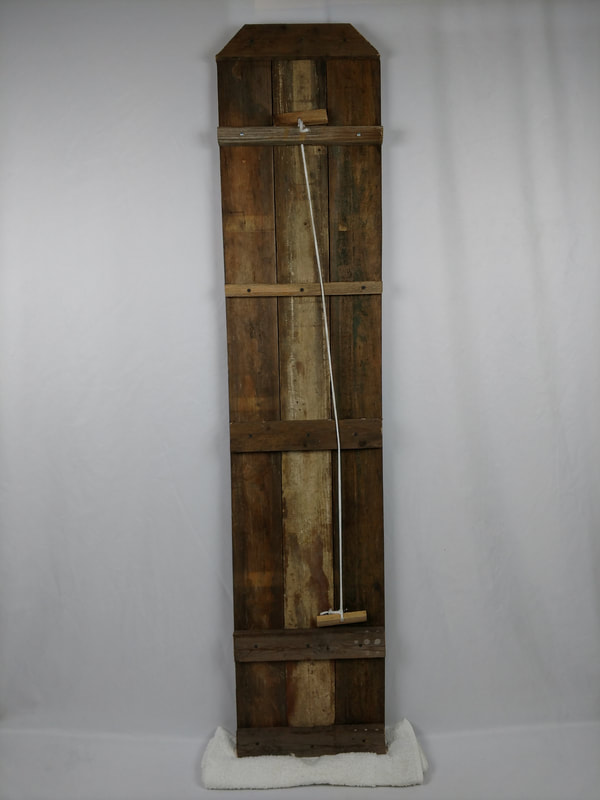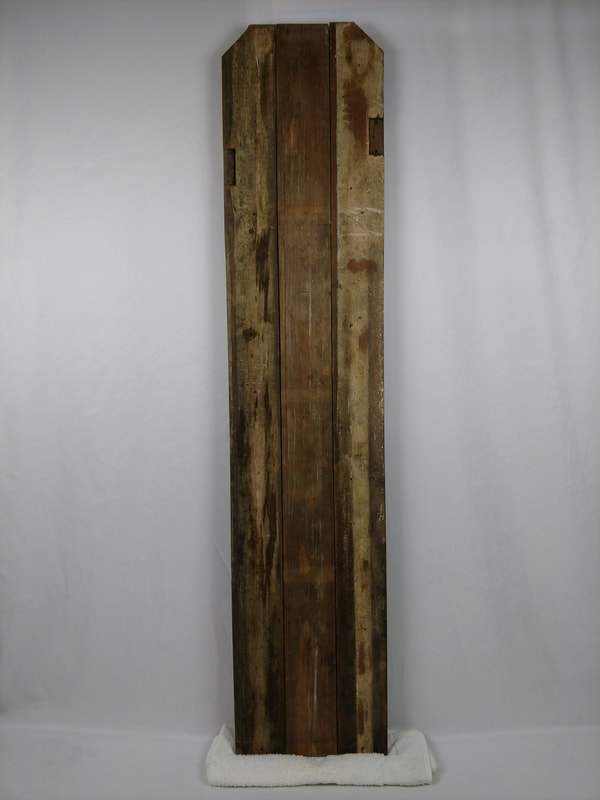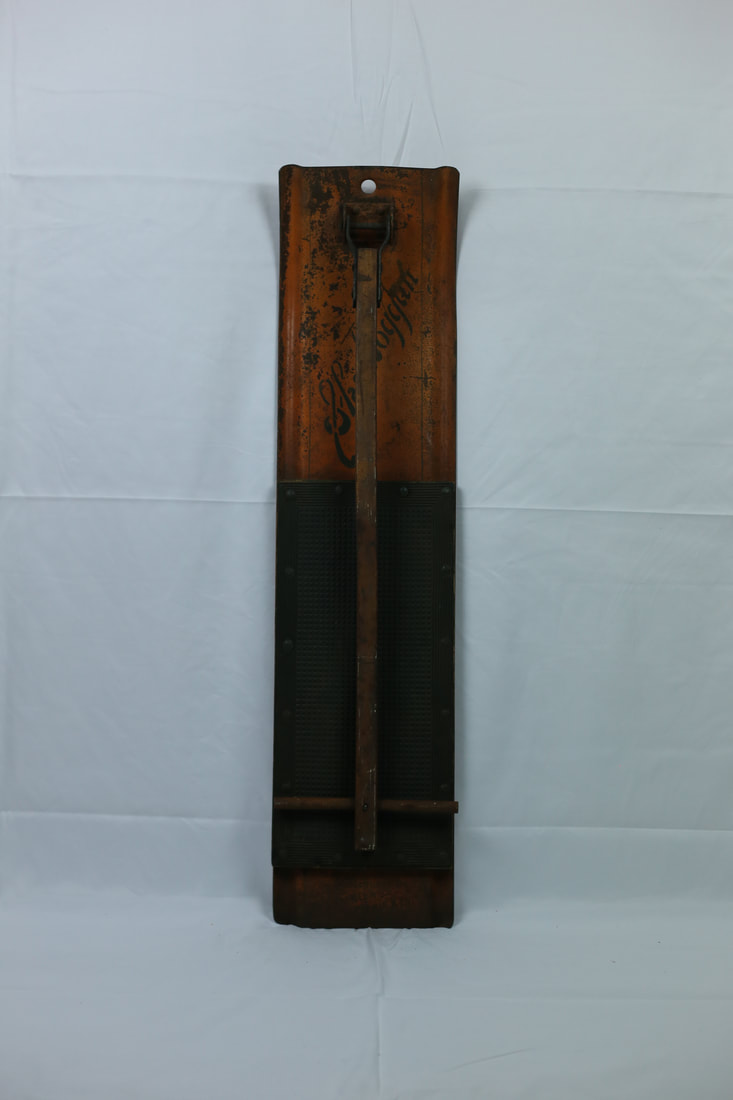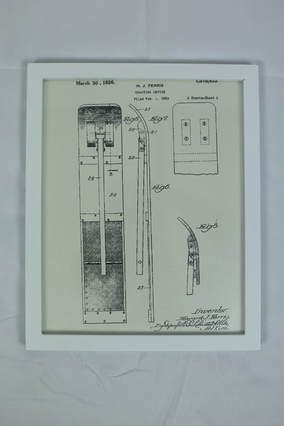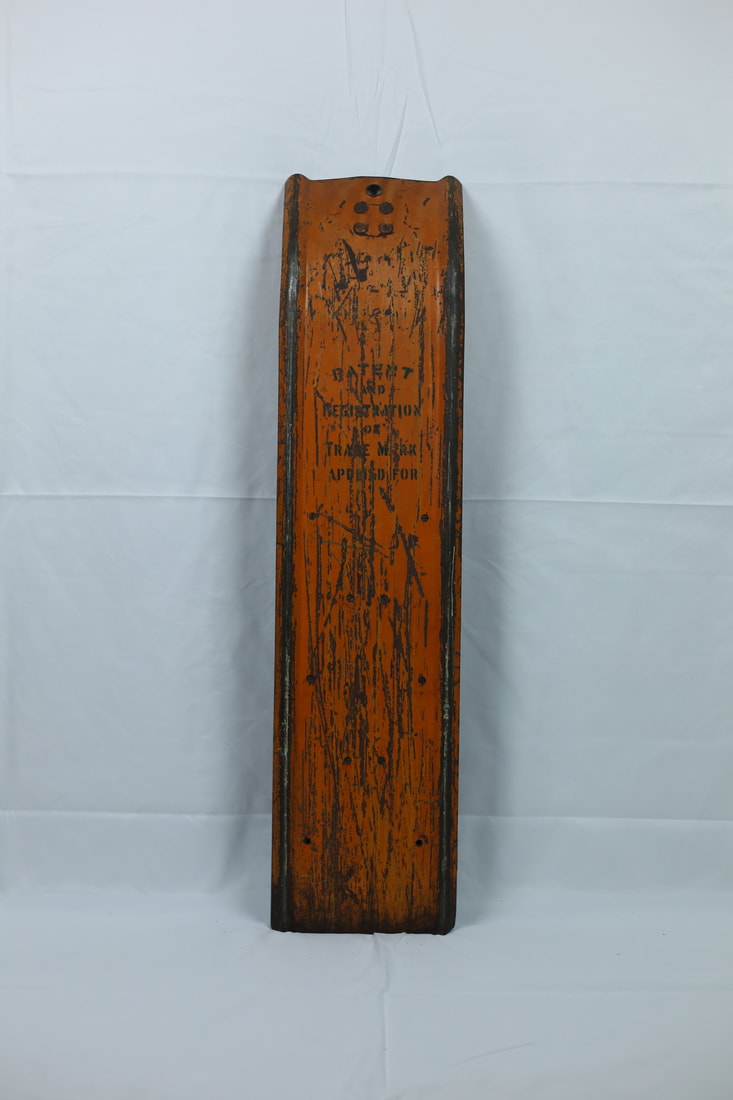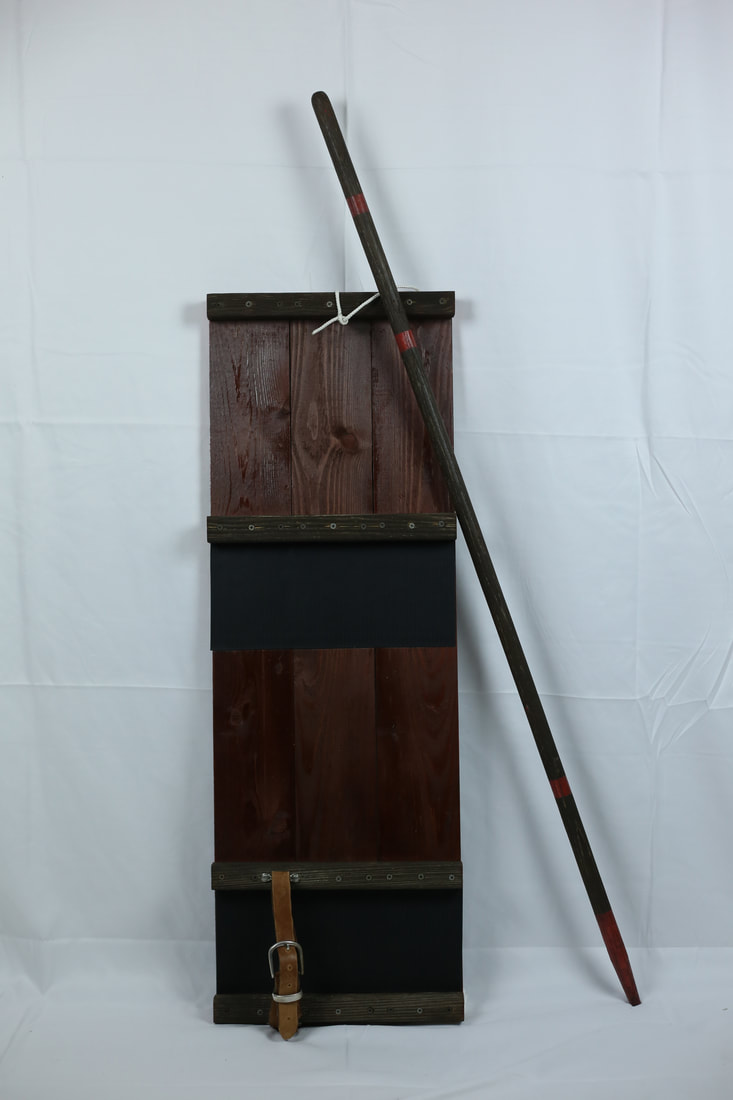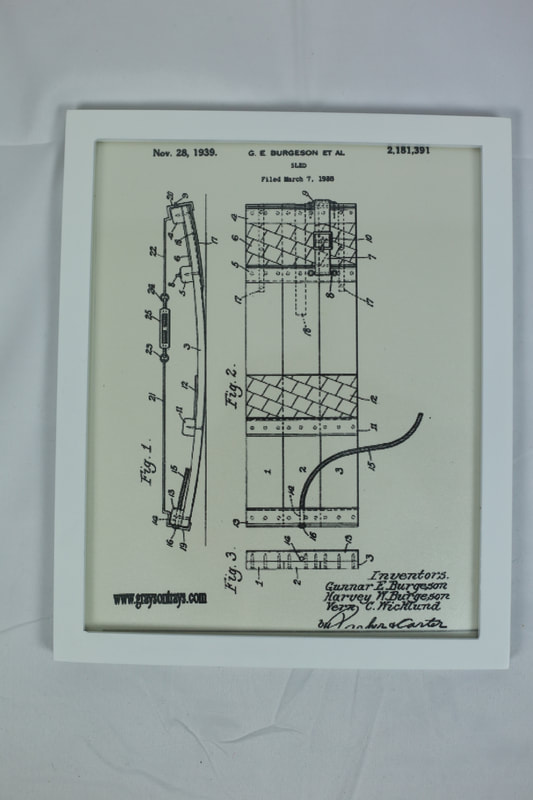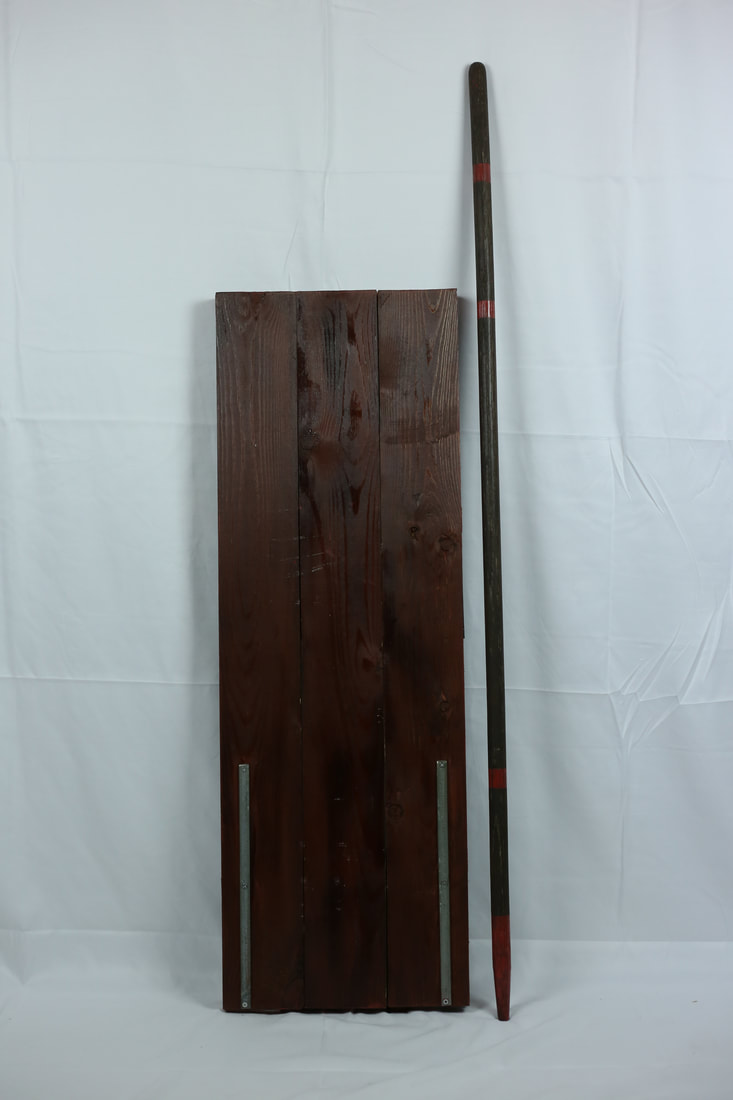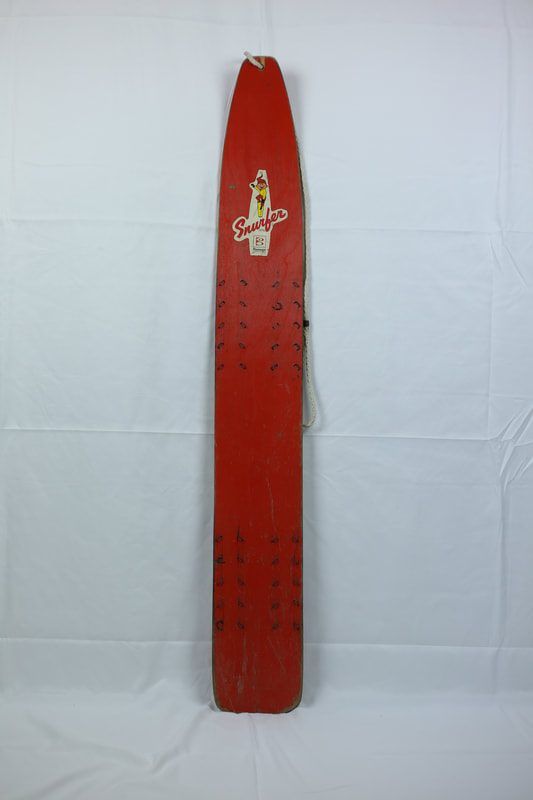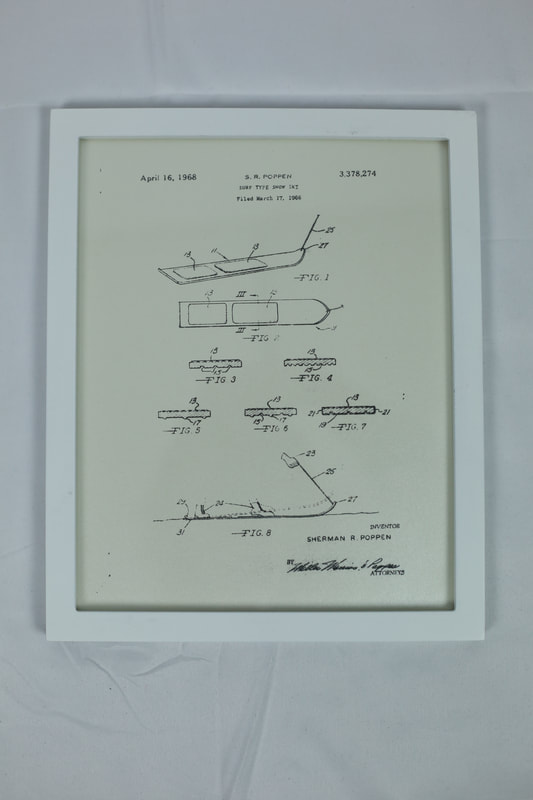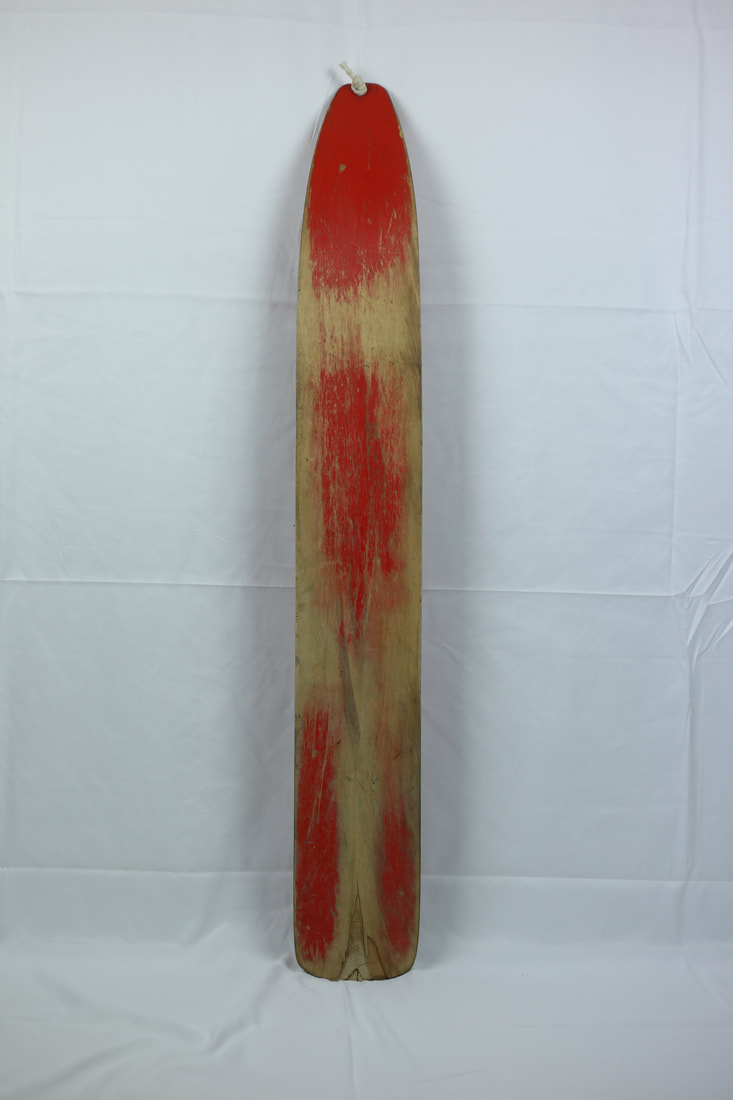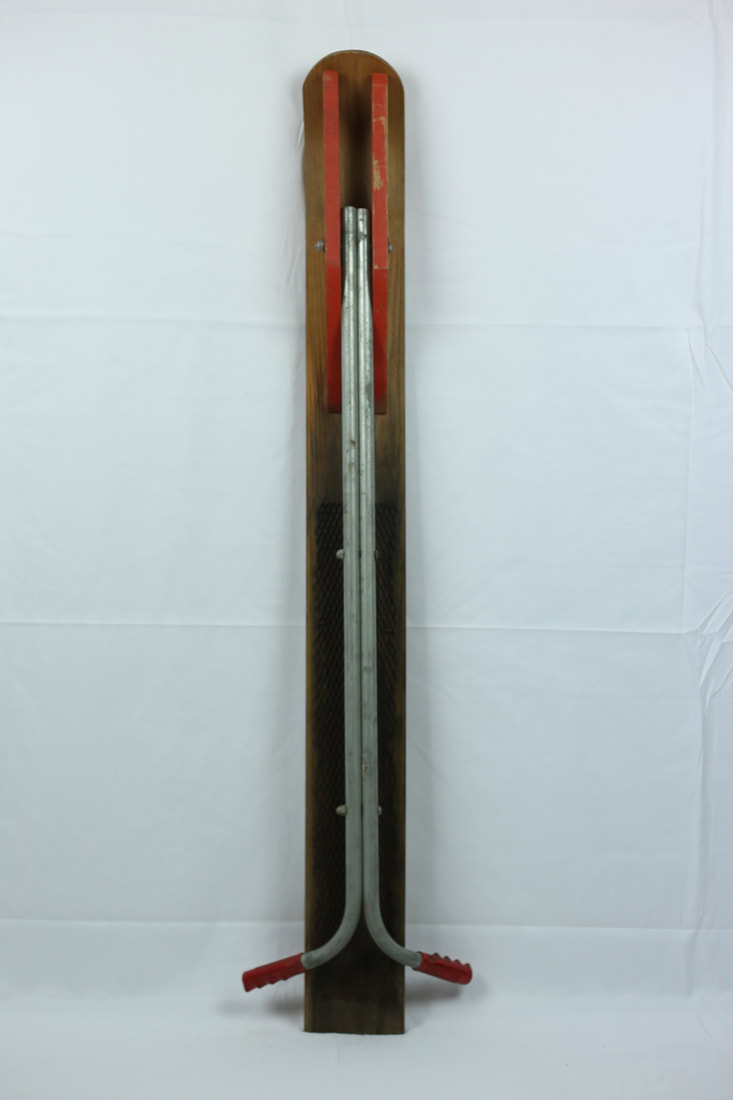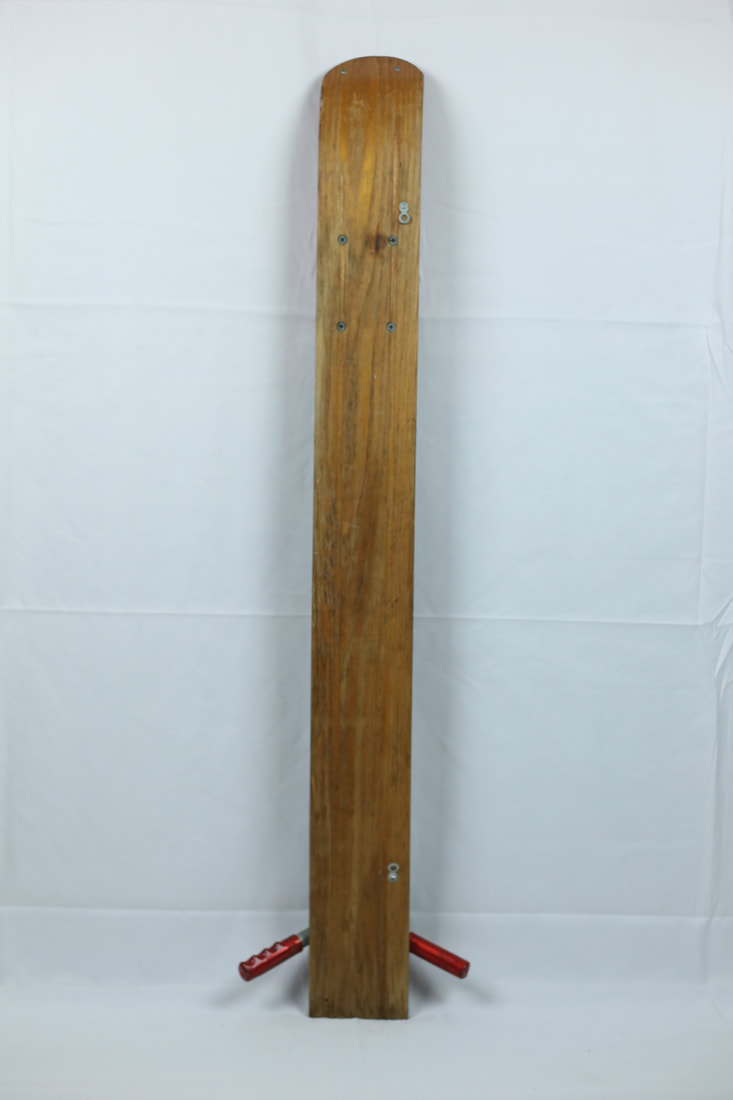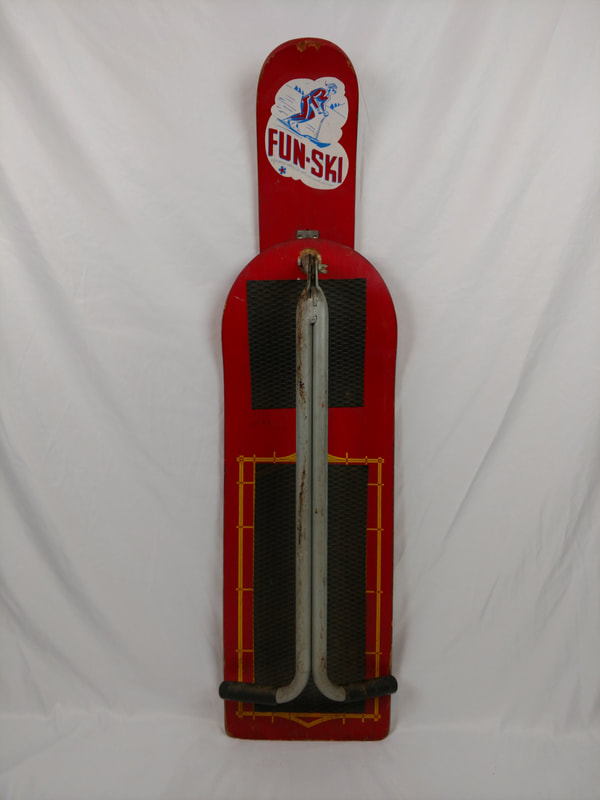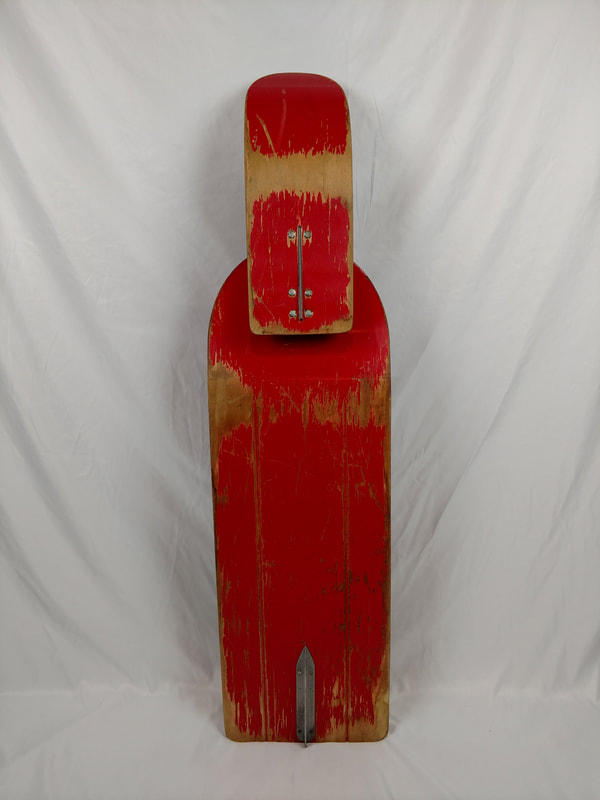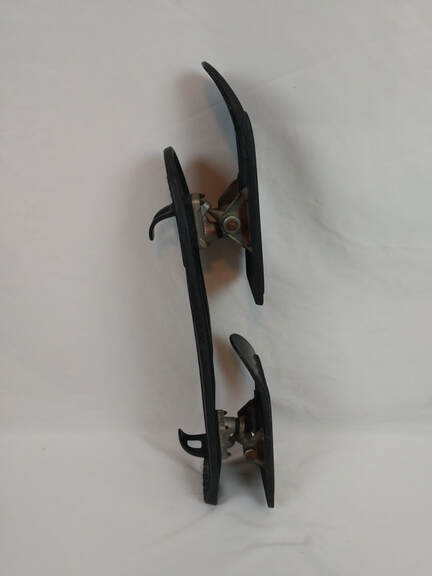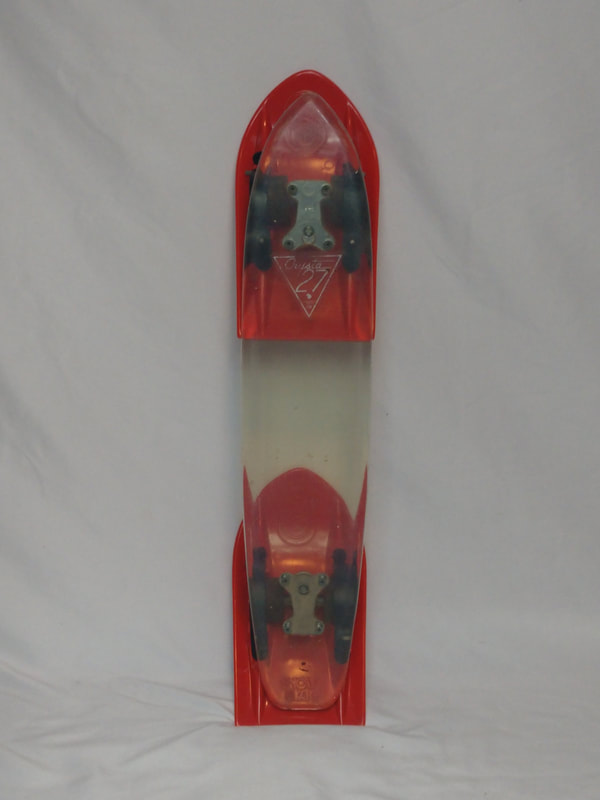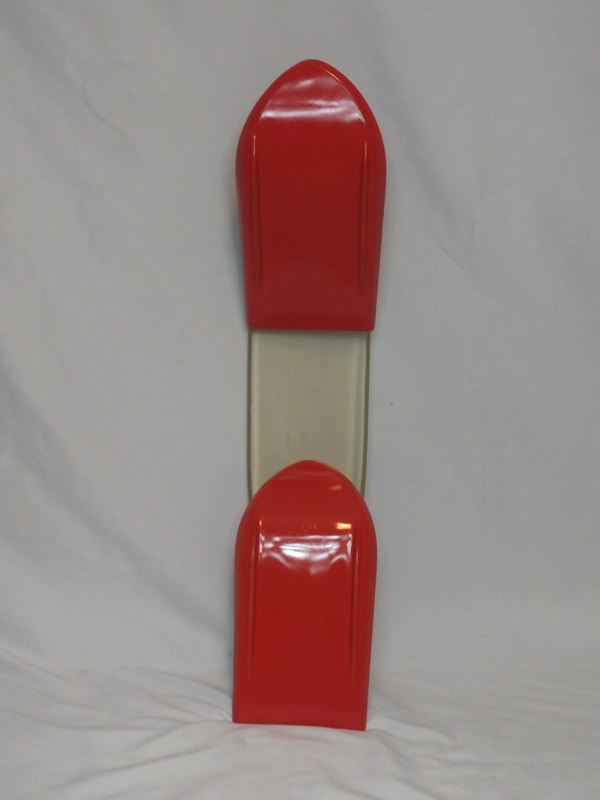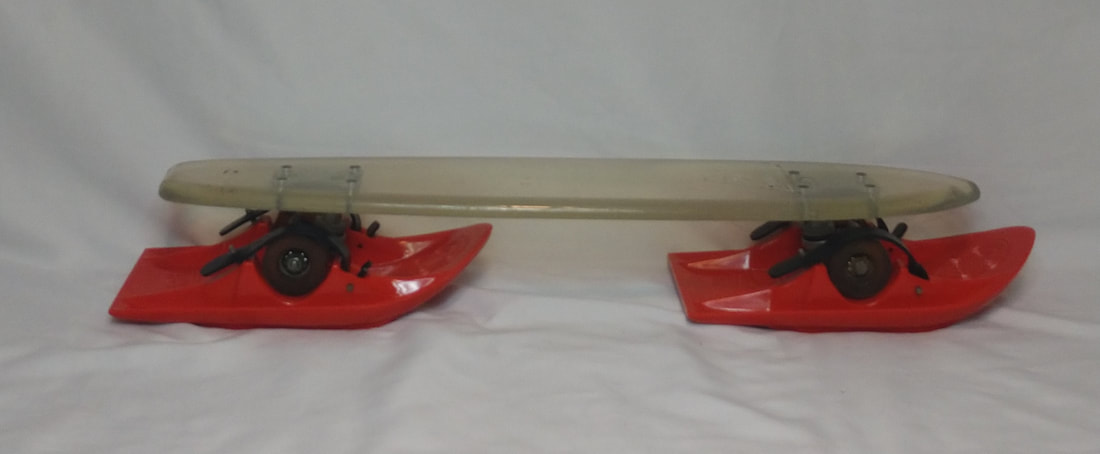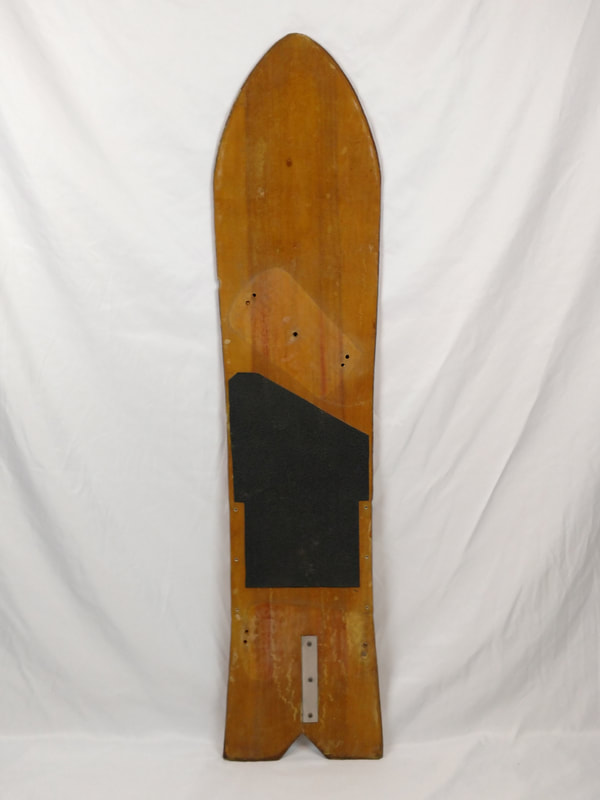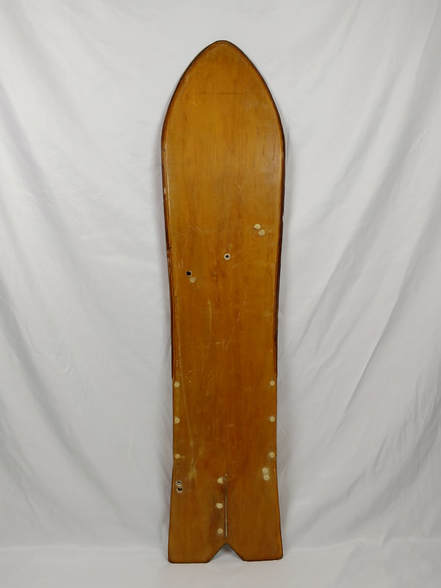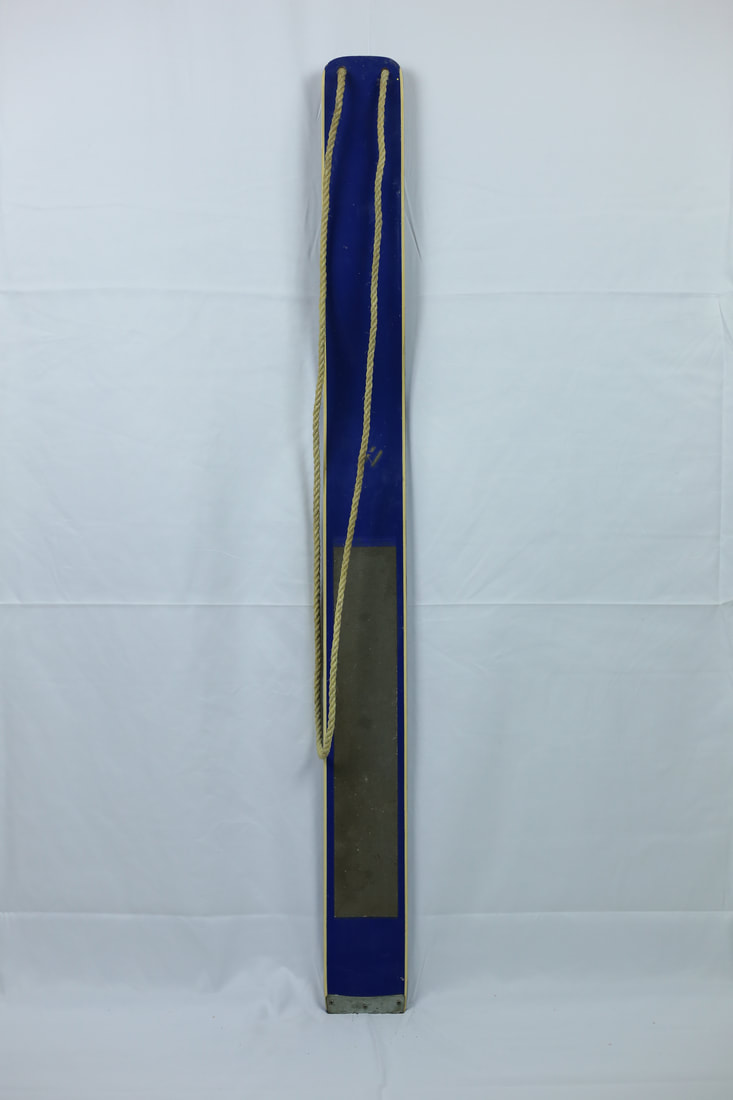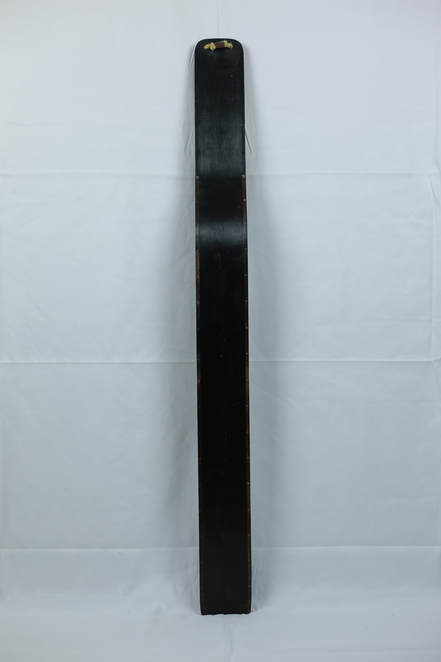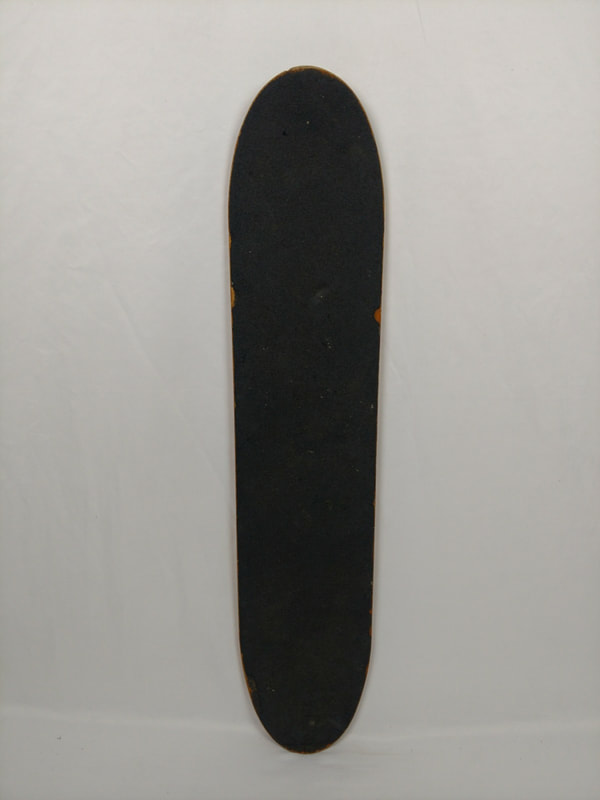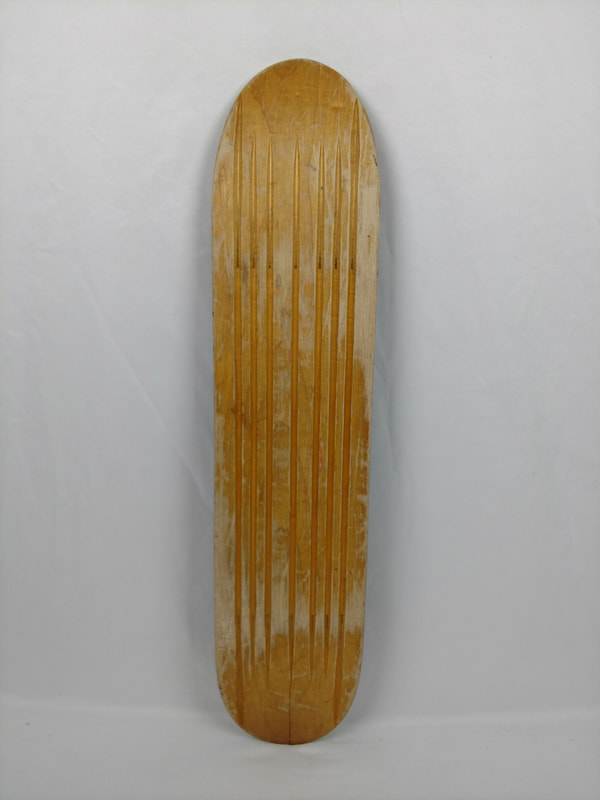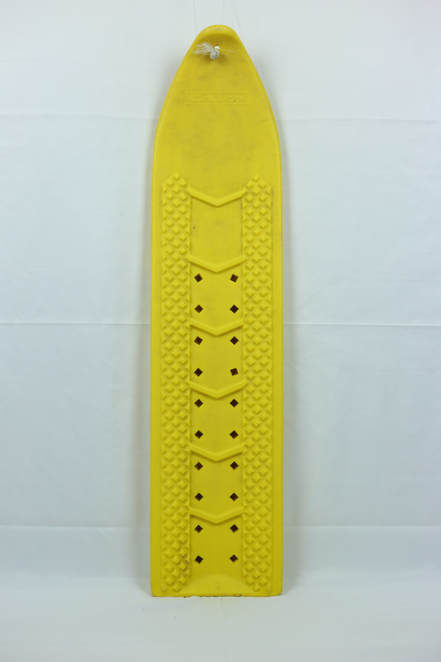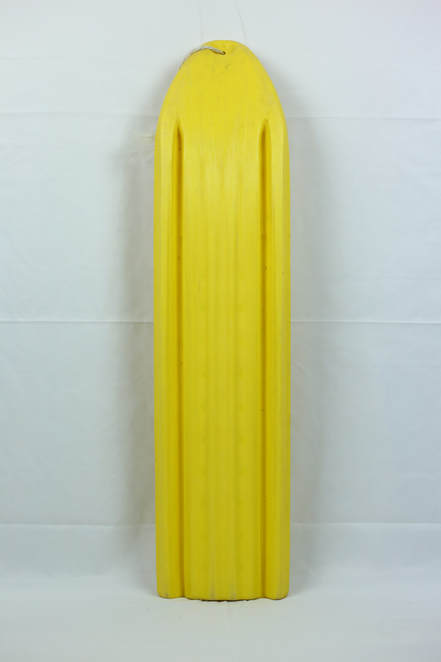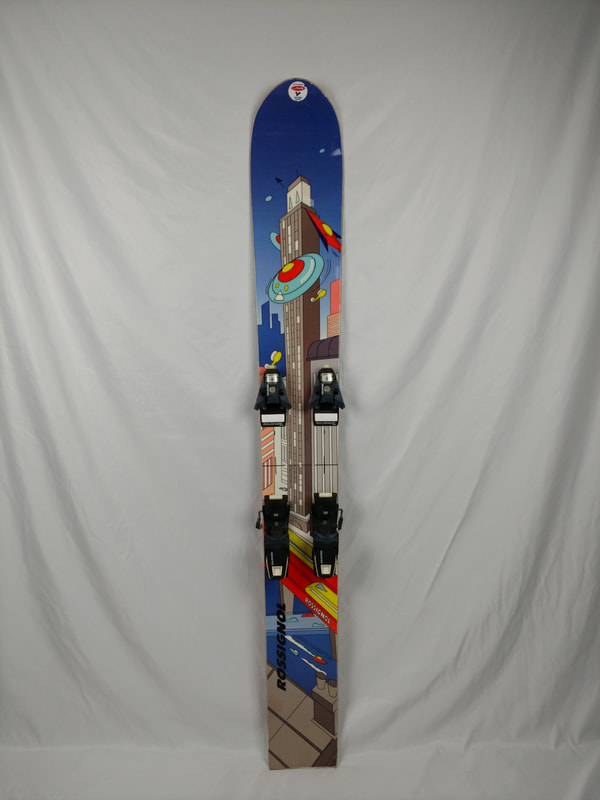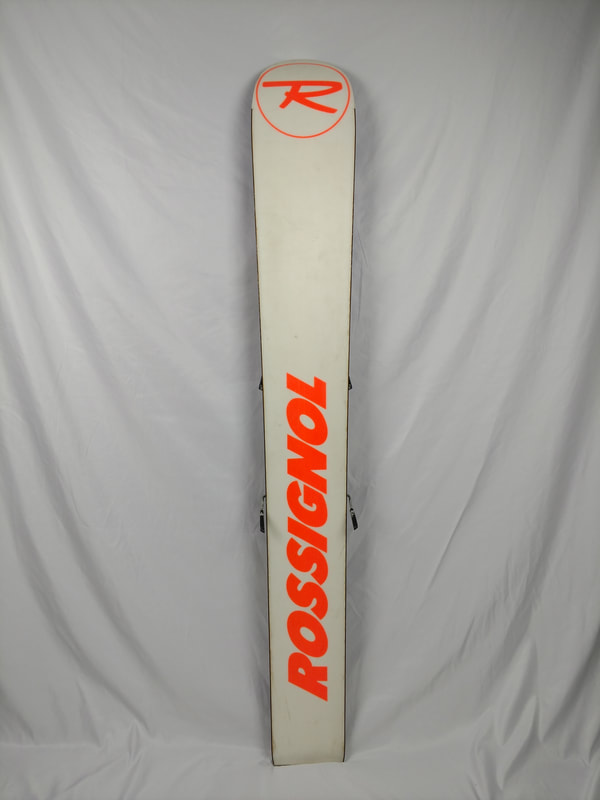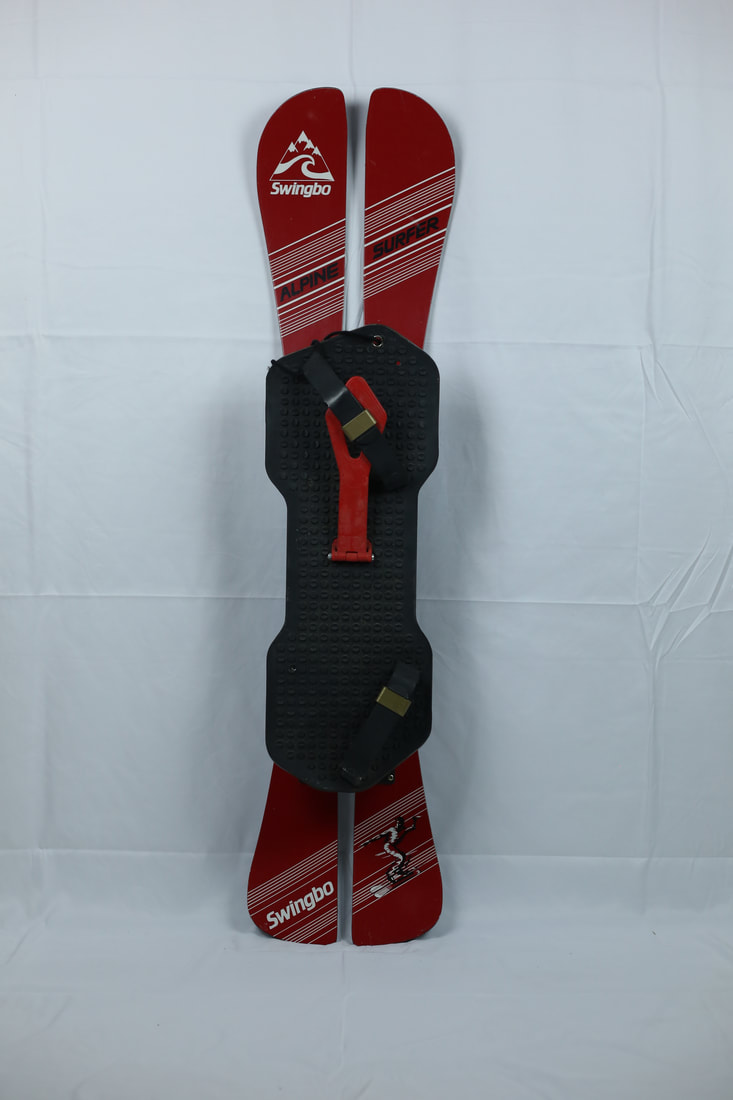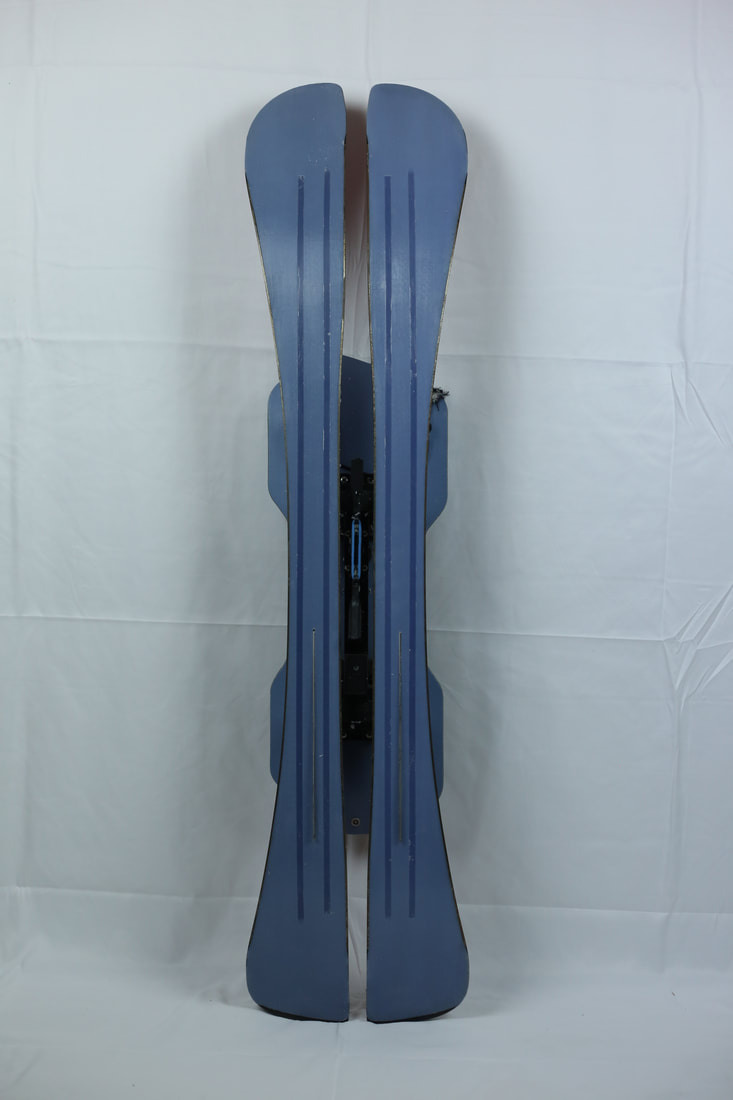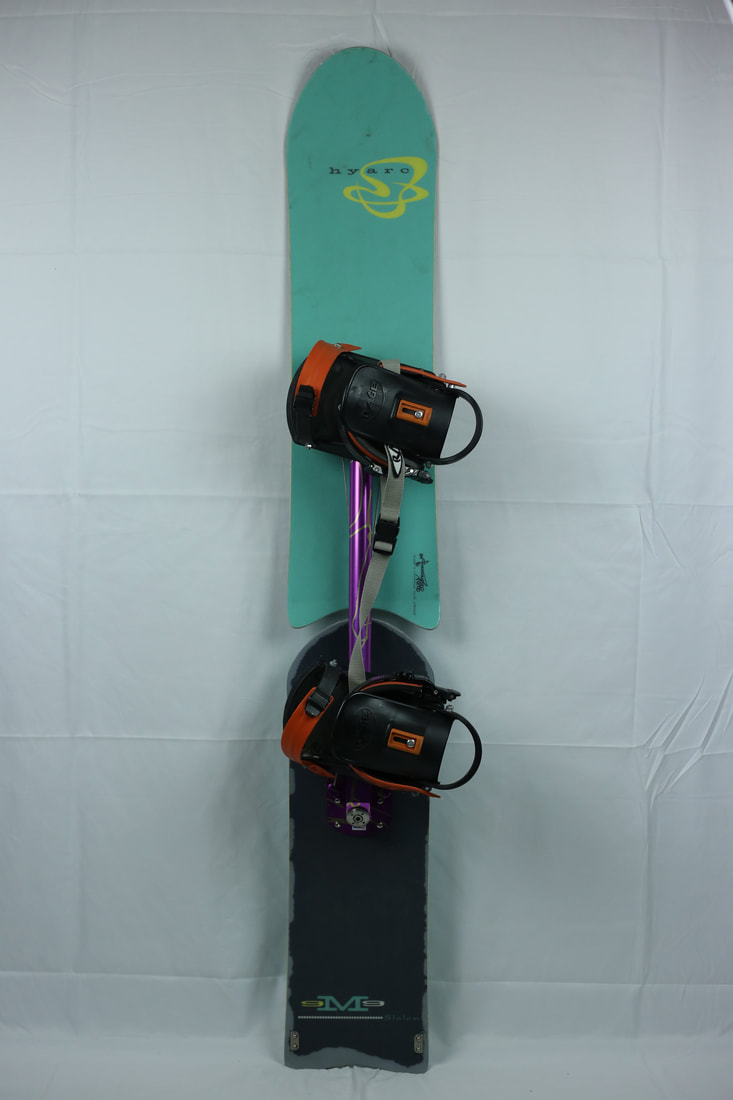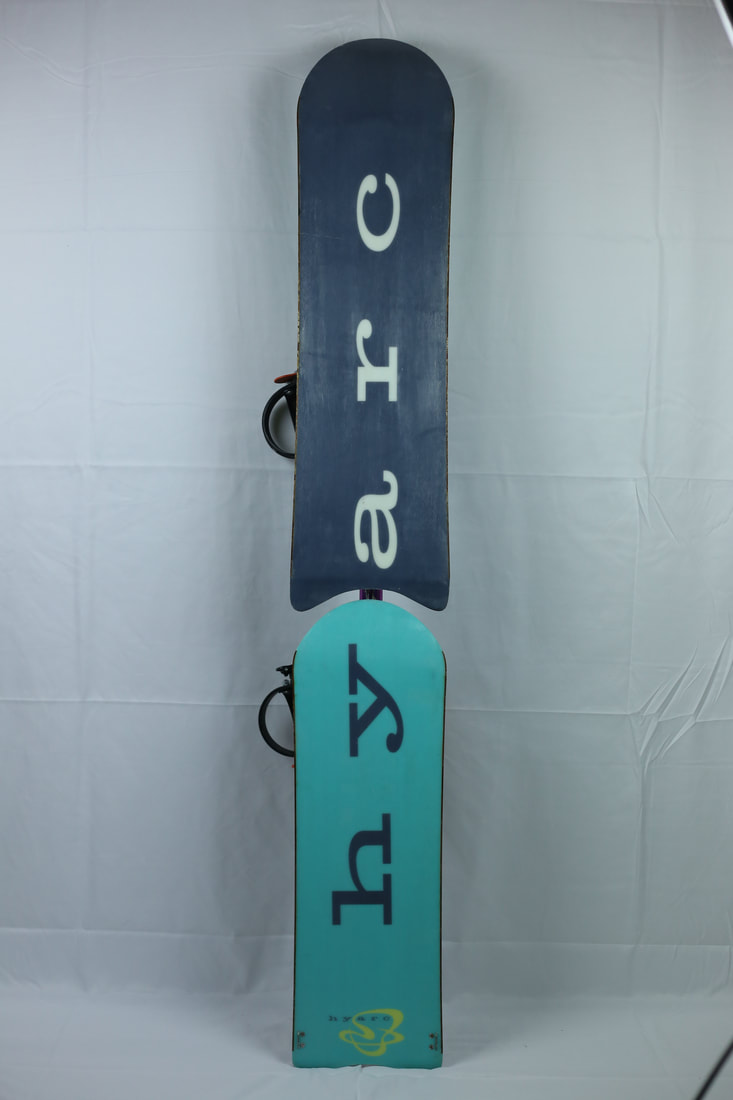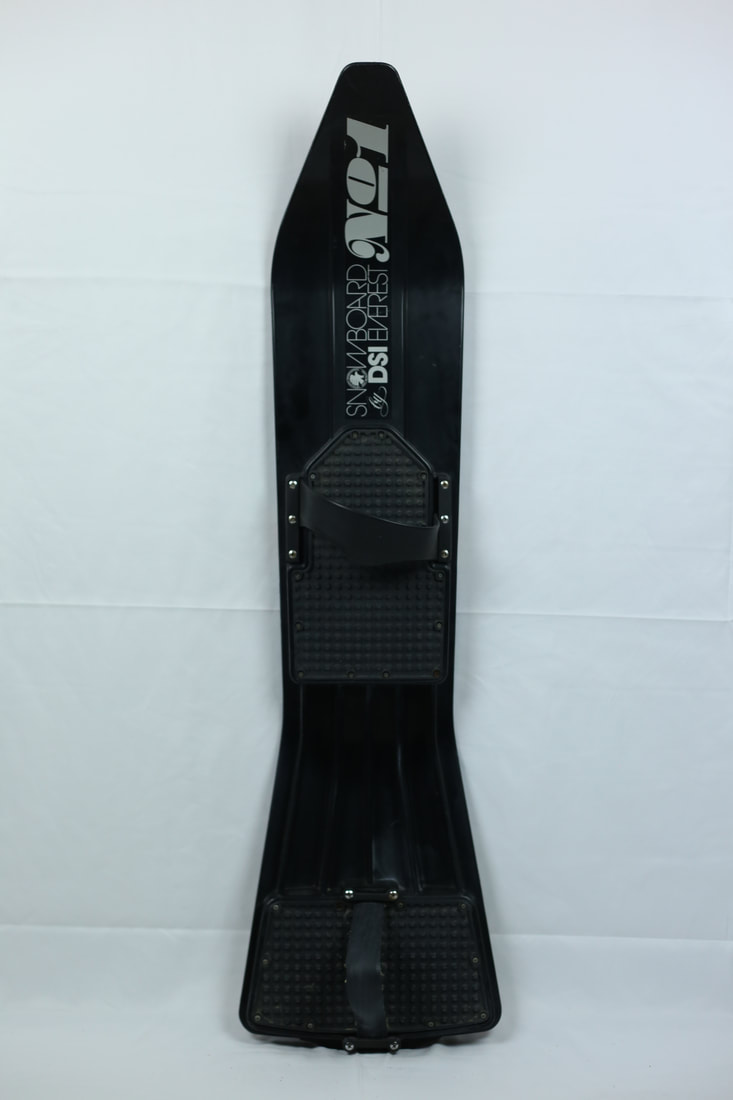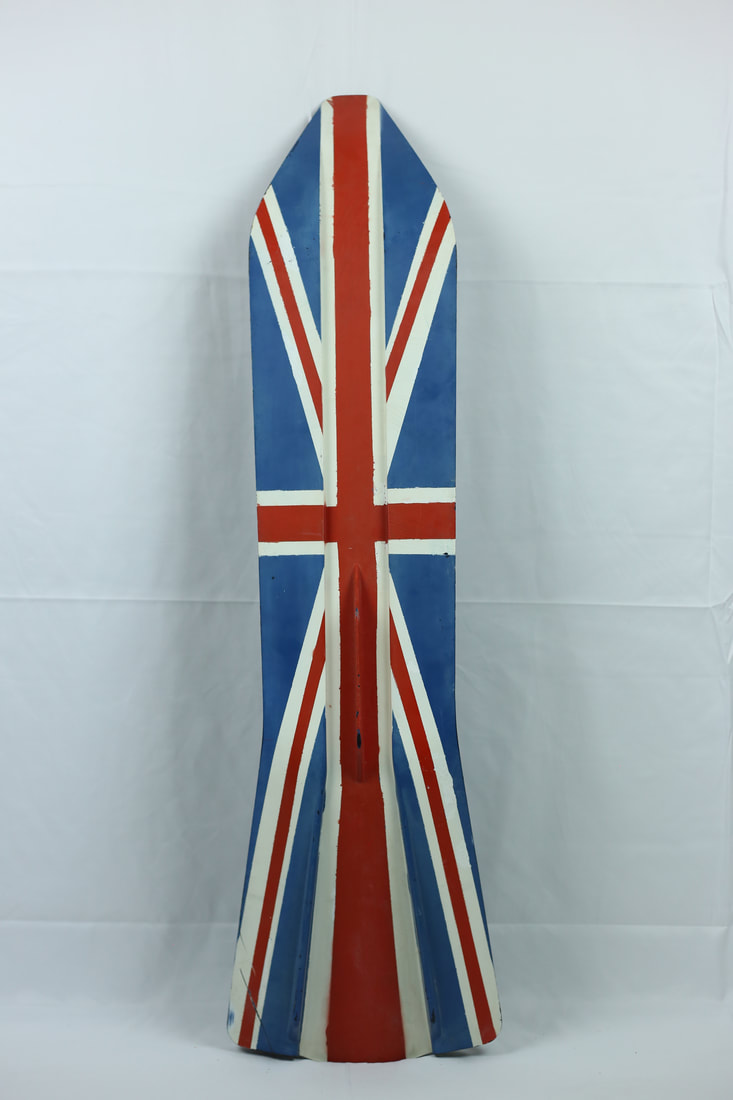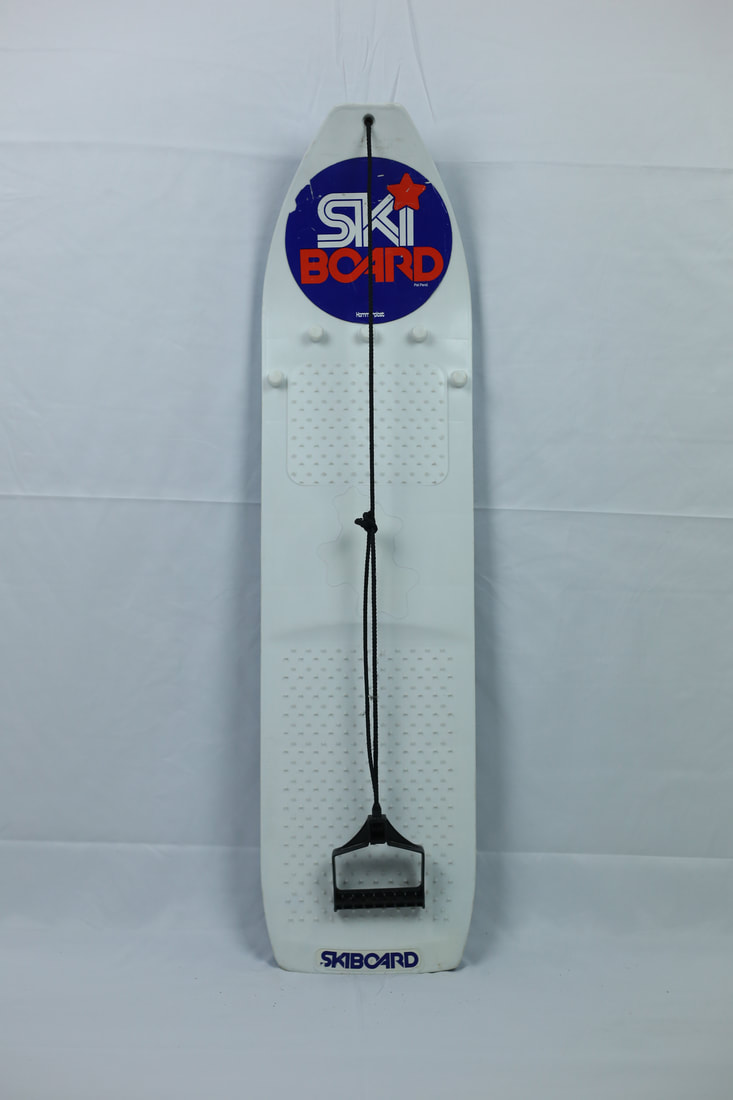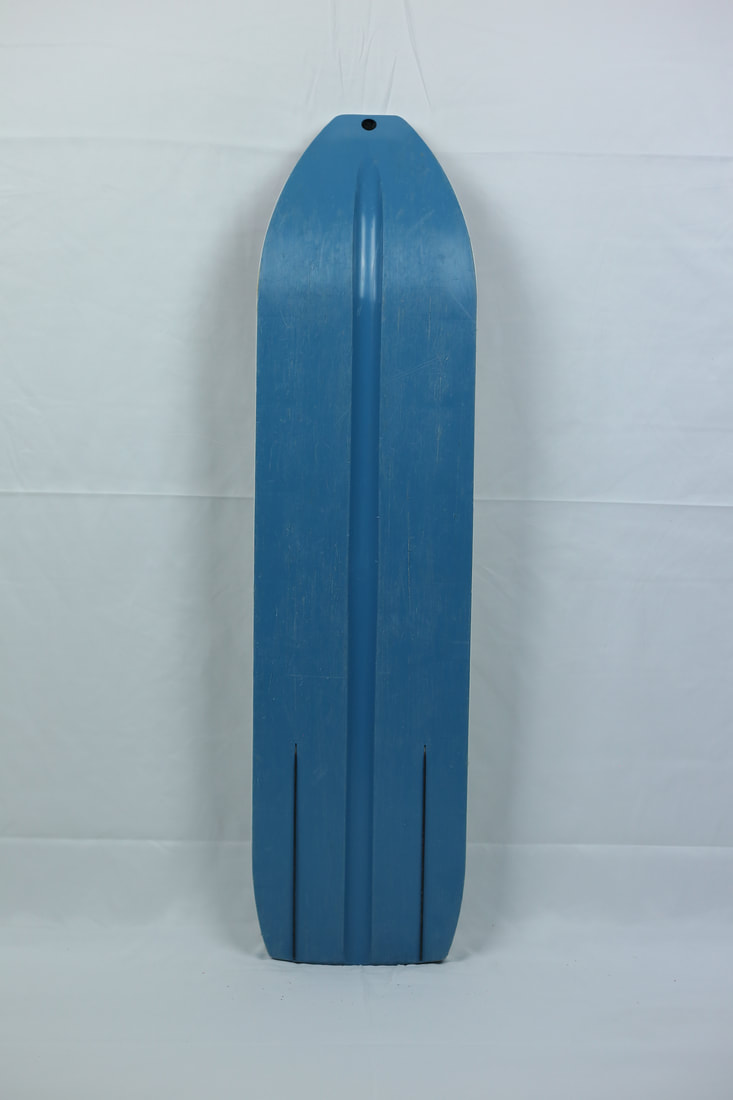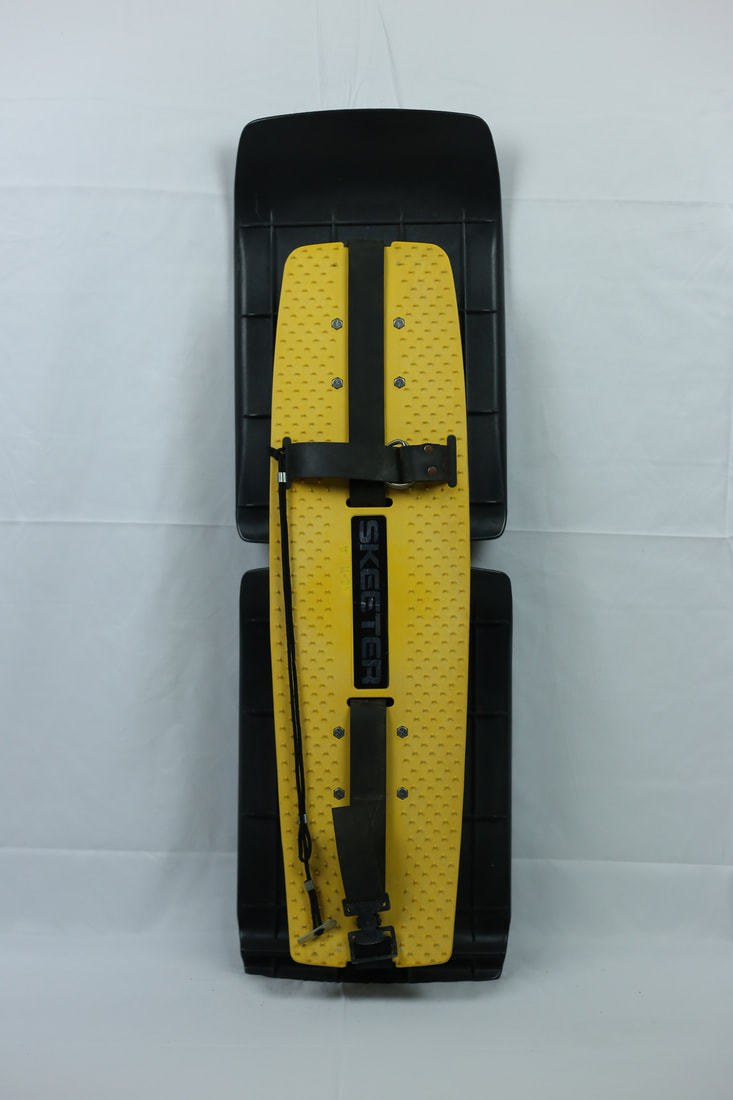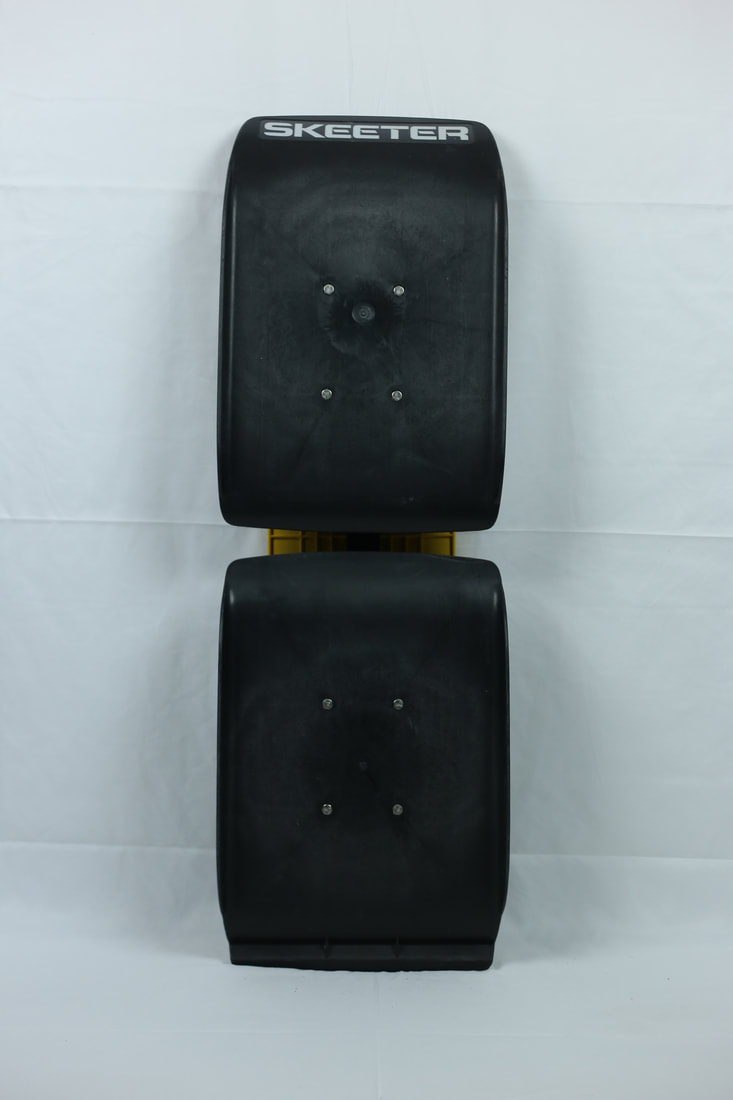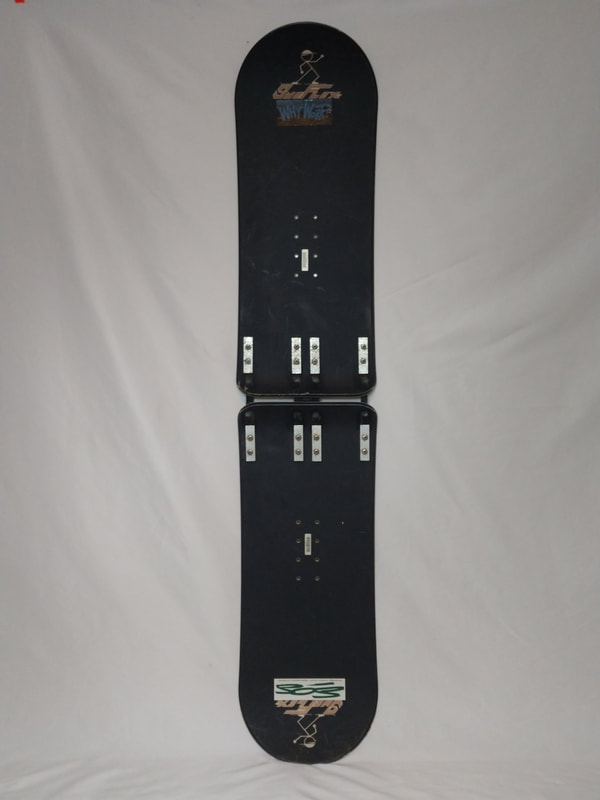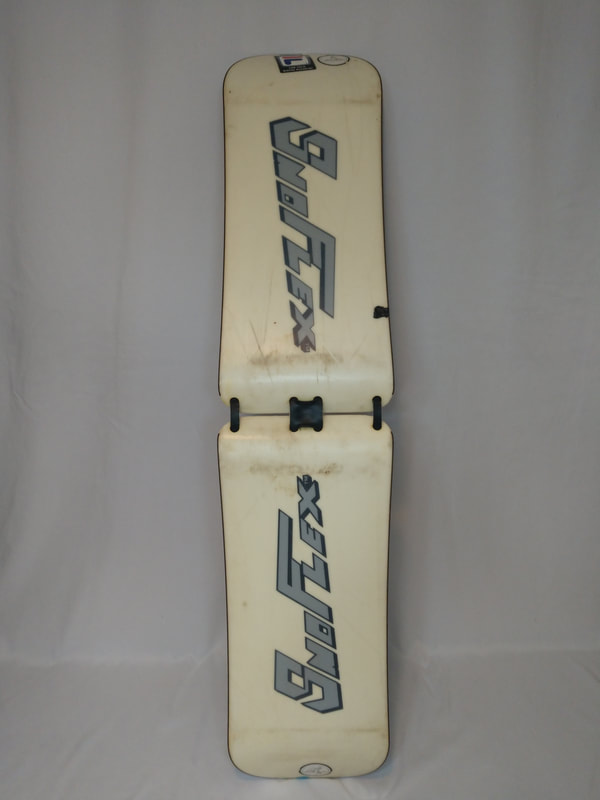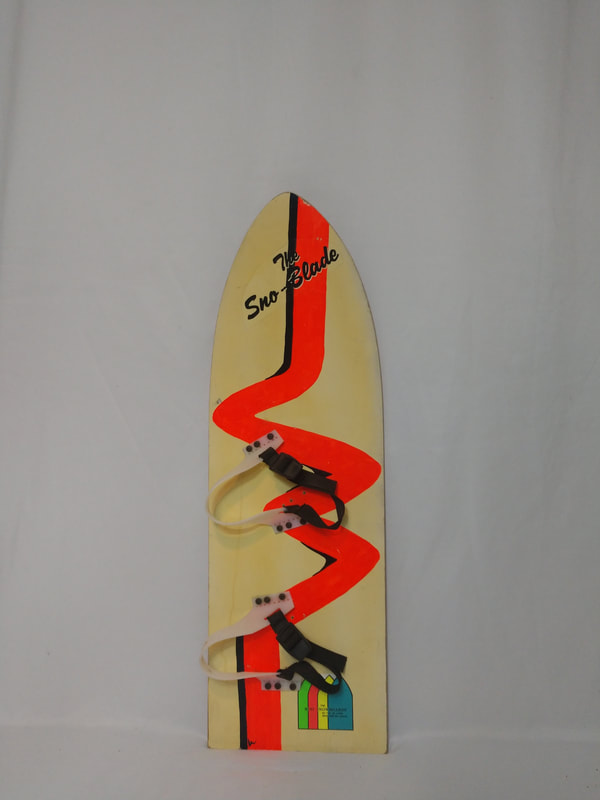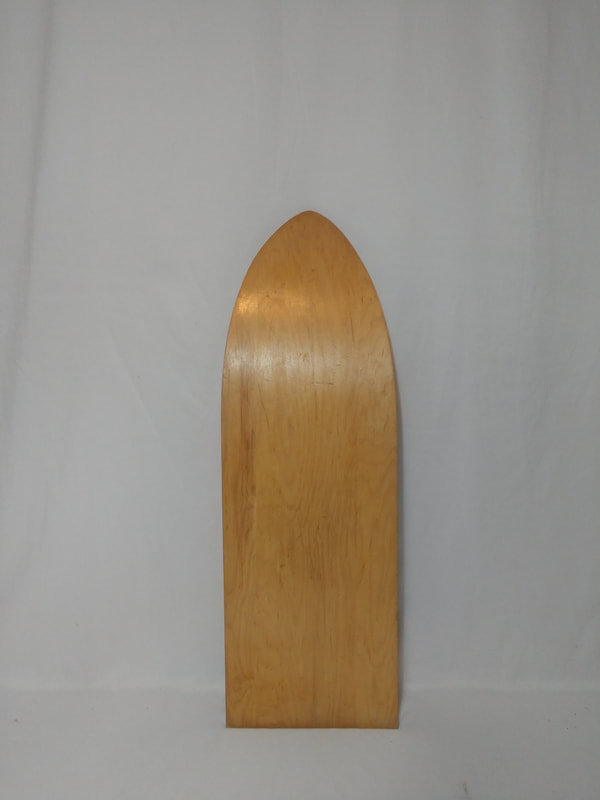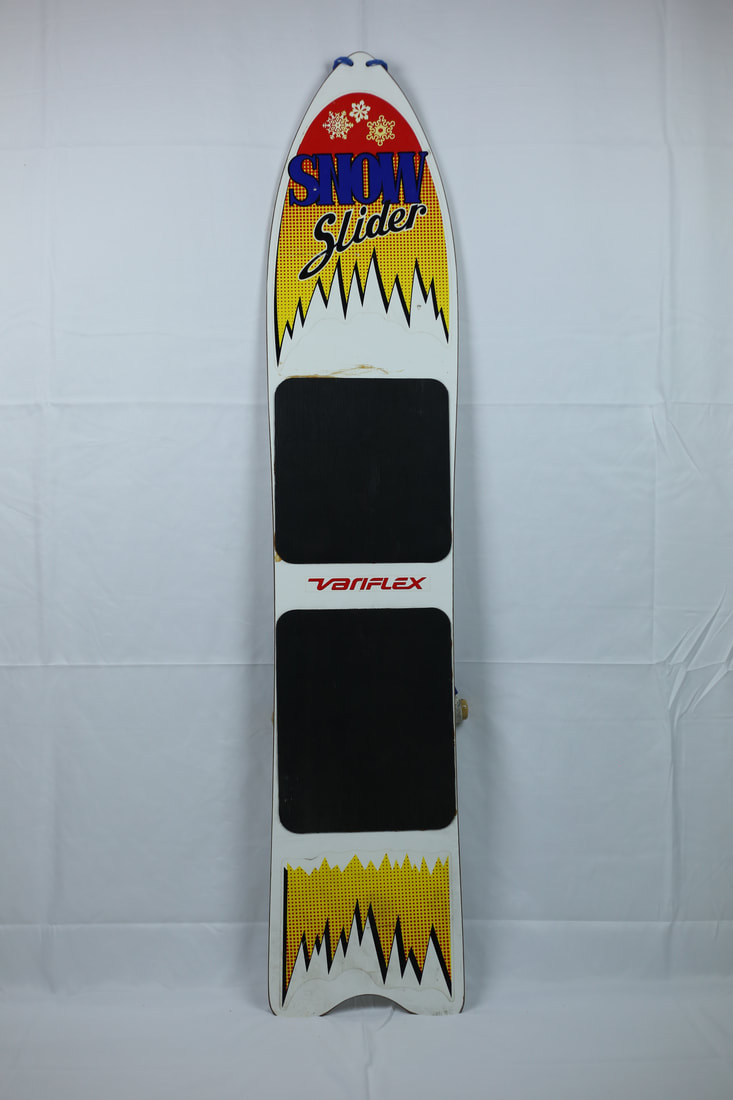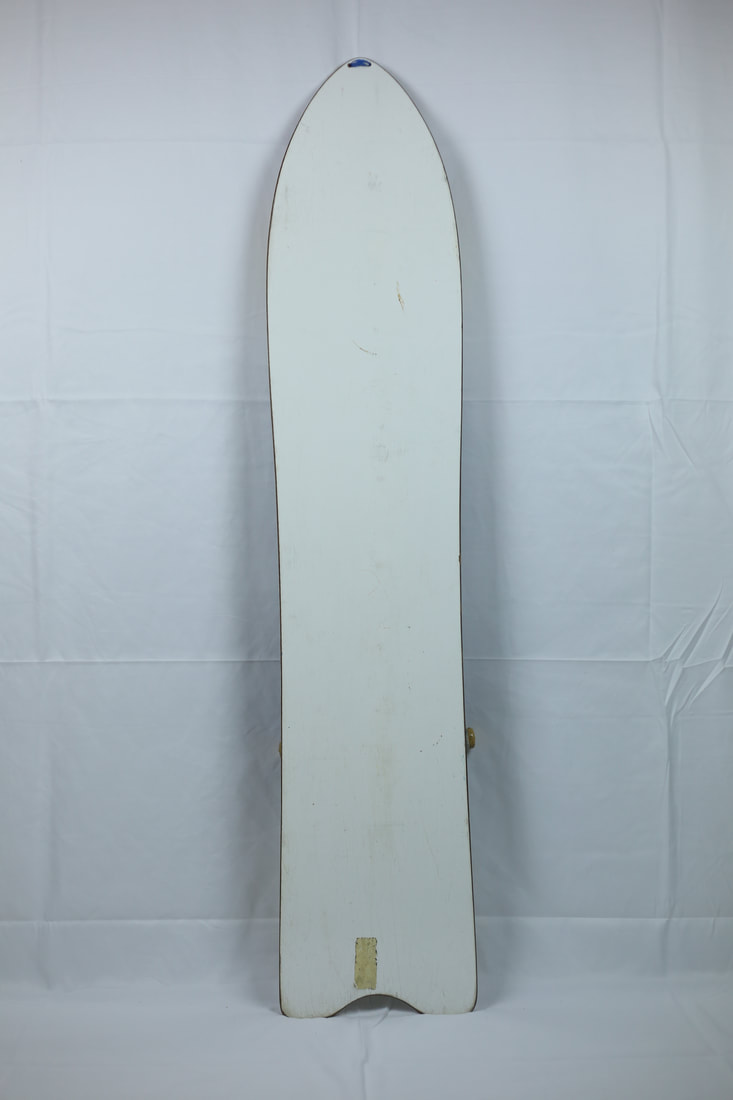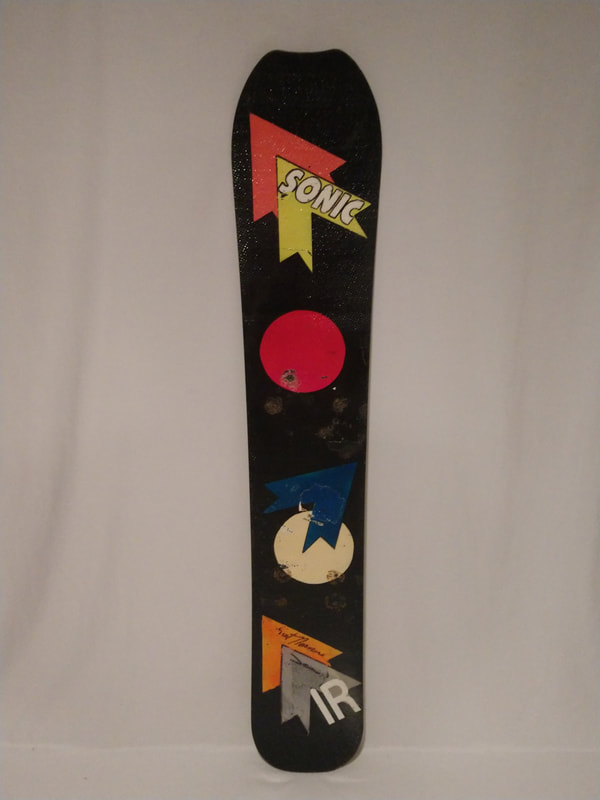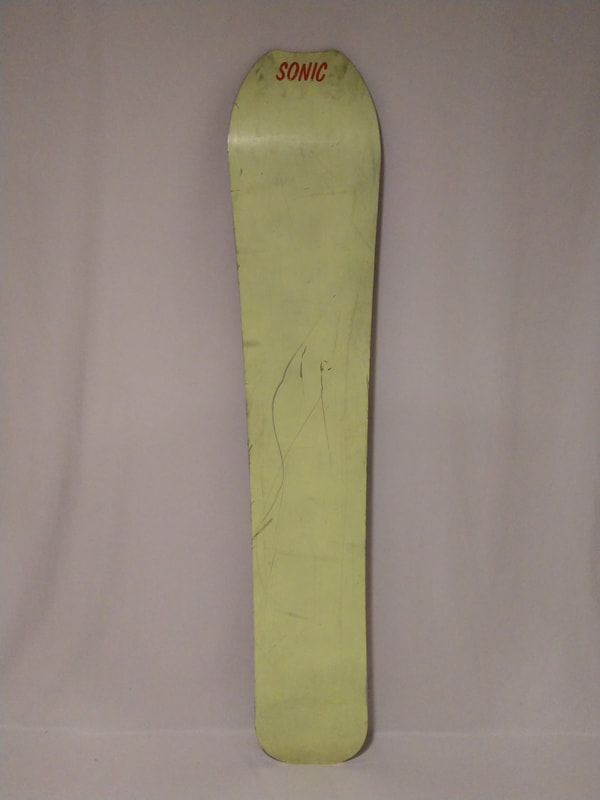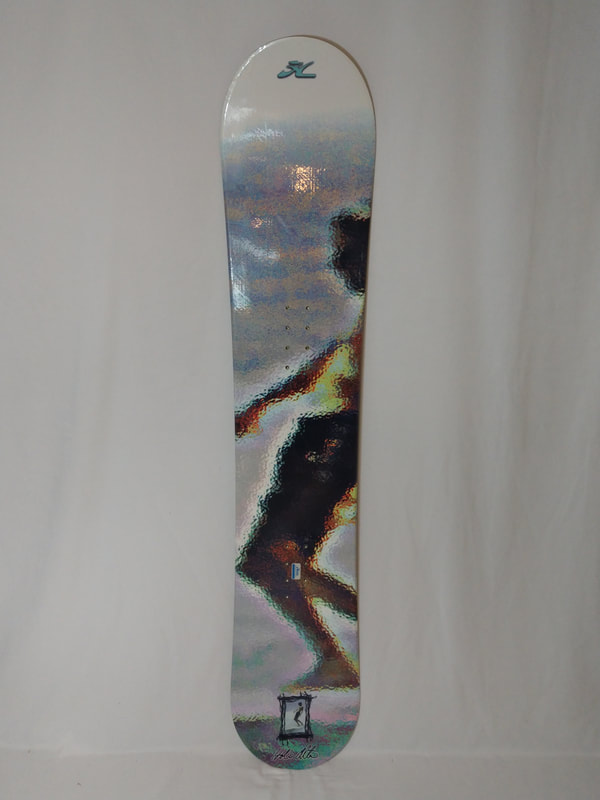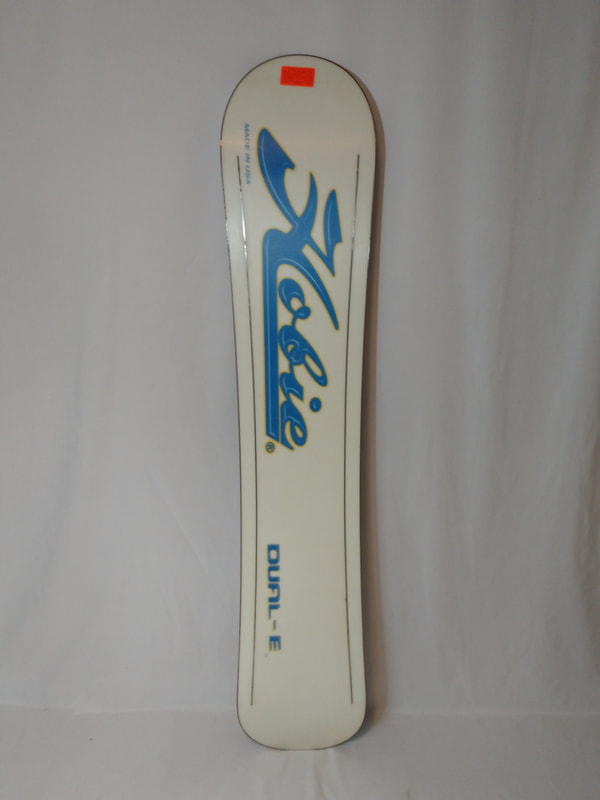- HOME & ABOUT
- EARLY NON-SNOWBOARD SLIDING DEVICES
- A HISTORY OF PROGRESSION, AND ATTEMPTS
- BOARDS FROM THE LEGENDS
- THE SNURFER
- SNURFER KNOCK OFFS
- BURTON - EARLY YEARS TO THE MODERN TWIN
- BURTON - FIRSTS & UNIQUE DECKS
- BURTON - 1980'S ACCESSORIES
- THE "NEON" ERA & OTHER 80'S DECKS
- DECKS WITH A MICHIGAN THEME & CONNECTION
- MICHIGAN LEGENDS AND MORE
- MICHIGAN STREET & PARK VIDS
- MICHIGAN SB PHOTO GALLERY
- MICHIGAN SNOWBOARDING HISTORY TIMELINE
- GLSS - GREAT LAKES SNOW SERIES OF USASA
- MHSSA - MICHIGAN HIGH SCHOOL SNOWBOARD ASSOCIATION
- OLD SNOWBOARD REFERENCE LIST
- CHARITIES, SPONSORSHIP & THANK YOU
- CONTACT
- FINAL WORDS
* * *
turkish villager snowboard toboggan - kackar mountains, turkey (1700's).
this board is a reproduction based on the best available information. it's was likely used to reach lower villages during the winter months in turkey's kackar mountain region. what makes it snowboard esque is that it was used standing up and standing sideways. the earliest known use dates back to the 1600's. it seems that most were head height, made of 3 or 4 vertical planks, 6 to 7 horizontal fixing braces which also served as foot braces. the handle & rope system allowed the rope to pass through the 2ed top brace so that the handle block stopped the rope from sliding through during the downhill, and then reversed the same function for pulling it back uphill - genius! front rocker was established by pulling up on the rope to curve the nose when heading downhill. these boards were recycled from and old structure in petoskey, mi courtesy of d. pizzuti.
this board is a reproduction based on the best available information. it's was likely used to reach lower villages during the winter months in turkey's kackar mountain region. what makes it snowboard esque is that it was used standing up and standing sideways. the earliest known use dates back to the 1600's. it seems that most were head height, made of 3 or 4 vertical planks, 6 to 7 horizontal fixing braces which also served as foot braces. the handle & rope system allowed the rope to pass through the 2ed top brace so that the handle block stopped the rope from sliding through during the downhill, and then reversed the same function for pulling it back uphill - genius! front rocker was established by pulling up on the rope to curve the nose when heading downhill. these boards were recycled from and old structure in petoskey, mi courtesy of d. pizzuti.
CLICK BELOW TO WATCH A 15 MINUTE VIDEO ON THE 300 YEAR OLD TURKISH ORIGINS OF SNOWBOARDING
* * *
Patent No. 1,578,415 filed feb 1, 1924
Skeeboggan (1920's)
Is this the first manufactured snowboard? This rare 1920’s invention was designed by Howard J. Ferris in his Harvard, IL workshop in the early 1920’s. It was subsequently awarded a patent on March 30, 1926. Mr. Ferris was well known for over 50 different inventions all produced and marketed under the name Hunt-Helm-Ferris & Company. This ski board’s revolutionary design allowed the rider to (as worded in the patent application)... “coast on snow covered slopes with greater control due to the downwardly projecting corrugated ribs formed in the sides of the sheet metal, which assisted in holding the coaster on a true course, particularly when passing over rough ground”. The handle allowed for easier balancing. It weighs in at 9 lbs. and measures 34-1/2” long x 8-1/4” wide. There is a rubber foot pad for traction.
Is this the first manufactured snowboard? This rare 1920’s invention was designed by Howard J. Ferris in his Harvard, IL workshop in the early 1920’s. It was subsequently awarded a patent on March 30, 1926. Mr. Ferris was well known for over 50 different inventions all produced and marketed under the name Hunt-Helm-Ferris & Company. This ski board’s revolutionary design allowed the rider to (as worded in the patent application)... “coast on snow covered slopes with greater control due to the downwardly projecting corrugated ribs formed in the sides of the sheet metal, which assisted in holding the coaster on a true course, particularly when passing over rough ground”. The handle allowed for easier balancing. It weighs in at 9 lbs. and measures 34-1/2” long x 8-1/4” wide. There is a rubber foot pad for traction.
* * *
Patent No. 2,181,391 filed march 7, 1938
WICKLUND/BURGESON "SNO-SURF” a.k.a. “THE BUNKER” (1929 - 1940's Reproduction):
This board is a “close to scale” reproduction made by the museum. Materials were picked and purchased. It weighs in at a whopping 12 lbs. and unlike the original has no rocker. The original was made of solid white oak possibly making it the heaviest plank in history. Original “Sno-Surf” prototypes are on display at the Colorado Ski & Snowboard Museum, on loan from Gunnar Burgeson’s son, Don Burgeson.
As the story goes... in 1926 Sweed’s Gunnar & Harvey Burgeson, along with relative Vern Wicklund immigrated to the United States. Coming from Scandinavia they were well acclimated to cold weather sporting activities. Settling in the Midwest (Oak Park, IL), the old country traditions involving winter & hills likely led to their invention. Perhaps in the earliest form of rebellion applicable to snowboarding’s roots, the three poached bigger and bigger hills by hopping fences to access (trespass) neighboring farmland.
rockered barrell planks were fixed together with wood strips. A friction pad, and a trousers belt to provide a binding system designed to “stand sideways”. The rope and stick were added to provide balance, with the added feature of pulling back on the rope to slow or stop – however the primary purpose of the rope was to tote the heavy board back uphill as rope or lift service was of course unavailable. The name “Sno-Surf” indicated that this was not a sit down sled, but the rudimentary beginnings of snowboarding itself. A patent was awarded in 1939 (though claims of building one in 1917 as kids WERE MADE). Between Wilson Sporting Goods turning down an offer to distribute the Sno-Surf, and the beginnings of WWII, the idea of commercializing the invention fizzled out. only 5 were ever produced.
*this lost and unknown story was unveiled at the 2000 SIA Trade Show by Burton Snowboards, which displayed the original patent, prototype, and reel to reel film of Vern Wicklund riding the device down a DuPage Country Club hill in Oak Park, IL, 1939. This remarkable "discovery" came about when a relative looking at a family keep sake box many years later, uncovered the 8mm film footage capturing the the inventor zipping down hills. Years later a Burton employee boarded a flight and was coincidentally seated near a Wicklund relative. The relative, hearing that The fellow passenger was employed at Burton, explained how her relative “invented” the snowboard. The Burton employee was probably amused, but just the same left contact info to forward the 8mm film. After seeing the lost footage Jake himself gave credit where credit was due at the 2000 SIA Show. The footage is the earliest known of anyone ever “snowboarding”.
*The planks for this reproduction came from siding off an old Burt Lake cottage near Topinabee, MI, courtesy of T. North.
This board is a “close to scale” reproduction made by the museum. Materials were picked and purchased. It weighs in at a whopping 12 lbs. and unlike the original has no rocker. The original was made of solid white oak possibly making it the heaviest plank in history. Original “Sno-Surf” prototypes are on display at the Colorado Ski & Snowboard Museum, on loan from Gunnar Burgeson’s son, Don Burgeson.
As the story goes... in 1926 Sweed’s Gunnar & Harvey Burgeson, along with relative Vern Wicklund immigrated to the United States. Coming from Scandinavia they were well acclimated to cold weather sporting activities. Settling in the Midwest (Oak Park, IL), the old country traditions involving winter & hills likely led to their invention. Perhaps in the earliest form of rebellion applicable to snowboarding’s roots, the three poached bigger and bigger hills by hopping fences to access (trespass) neighboring farmland.
rockered barrell planks were fixed together with wood strips. A friction pad, and a trousers belt to provide a binding system designed to “stand sideways”. The rope and stick were added to provide balance, with the added feature of pulling back on the rope to slow or stop – however the primary purpose of the rope was to tote the heavy board back uphill as rope or lift service was of course unavailable. The name “Sno-Surf” indicated that this was not a sit down sled, but the rudimentary beginnings of snowboarding itself. A patent was awarded in 1939 (though claims of building one in 1917 as kids WERE MADE). Between Wilson Sporting Goods turning down an offer to distribute the Sno-Surf, and the beginnings of WWII, the idea of commercializing the invention fizzled out. only 5 were ever produced.
*this lost and unknown story was unveiled at the 2000 SIA Trade Show by Burton Snowboards, which displayed the original patent, prototype, and reel to reel film of Vern Wicklund riding the device down a DuPage Country Club hill in Oak Park, IL, 1939. This remarkable "discovery" came about when a relative looking at a family keep sake box many years later, uncovered the 8mm film footage capturing the the inventor zipping down hills. Years later a Burton employee boarded a flight and was coincidentally seated near a Wicklund relative. The relative, hearing that The fellow passenger was employed at Burton, explained how her relative “invented” the snowboard. The Burton employee was probably amused, but just the same left contact info to forward the 8mm film. After seeing the lost footage Jake himself gave credit where credit was due at the 2000 SIA Show. The footage is the earliest known of anyone ever “snowboarding”.
*The planks for this reproduction came from siding off an old Burt Lake cottage near Topinabee, MI, courtesy of T. North.
click below to see 5 min's of the first known film of snowboarding on the original "snow-surf bunkers"
* * *
patent no. 3.378,274 filed march 17, 1966
Snurfer (late 1960's)
On Christmas morning 1965, an invention was born in Muskegon, MI that would inspire an entire generation of snow sports enthusiasts. The inventor was Sherman Poppen who owned several industrial gas supply stores on Michigan’s west coast. When Sherman strapped two skies together for his daughters to slide down the snow covered sand dunes of Lake Michigan for entertainment, he made snowboard history. His wife coined the name “Snurfer” by mixing the words snow and surf – exactly what they were doing. The neighborhood kids loved this new toy as well, and Sherman began scouring the Goodwill stores for old skis to keep up with demand. Two skis evolved into one board with raised staples for traction, and a rope to steer, brake and haul. Sherman being a businessman obtained a patent and sold the Snurfer on a royalty basis Via Brunswick Corporation, and later through JEM Corp. In the end millions of snurfers were sold (even in supermarkets) for use on hills across America.
*This Snurfer found in Grand Rapids, MI.
On Christmas morning 1965, an invention was born in Muskegon, MI that would inspire an entire generation of snow sports enthusiasts. The inventor was Sherman Poppen who owned several industrial gas supply stores on Michigan’s west coast. When Sherman strapped two skies together for his daughters to slide down the snow covered sand dunes of Lake Michigan for entertainment, he made snowboard history. His wife coined the name “Snurfer” by mixing the words snow and surf – exactly what they were doing. The neighborhood kids loved this new toy as well, and Sherman began scouring the Goodwill stores for old skis to keep up with demand. Two skis evolved into one board with raised staples for traction, and a rope to steer, brake and haul. Sherman being a businessman obtained a patent and sold the Snurfer on a royalty basis Via Brunswick Corporation, and later through JEM Corp. In the end millions of snurfers were sold (even in supermarkets) for use on hills across America.
*This Snurfer found in Grand Rapids, MI.
click the link below to see a two minute old school video on snurfing
* * *
Adirondack Ski Board (1960's): Adirondack-Peters Co. roots began in 1830 as a sawmill operation named John M. Peters & Sons that slowly began to integrate upwards by making useful wooden products for that era. A merger between F.D. Peters and Adirondack Manufacturing in 1962 consolidated the companies. They continued as a regional wood manufacturer based in Dolgeville, NY, that produced baseball bats, bowling pins and water skis. More importantly (as far as we're concerned) they also made sleds, toboggans, snow skis, and of course this unique snowboard/ski out of their Gloversville, NY plant. It is believed they ceased operations in the late 1970's.
*This ski board was owned by "Mr. Bock" from Dearborn, MI. R.I.P
*This ski board was owned by "Mr. Bock" from Dearborn, MI. R.I.P
* * *
fun ski (1970)
like others before and after, the owner of this bridgman, mi company was most likely inspired to create this dual deck due to the generous amounts of lake effect snow that covered nearby warren dunes state park. its 47" in length and has a 12" wide beam. the front & rear traction mats made for a stable platform where one could choose a goofy-right or straight-left foot forward stance (although toes pointed more forward). the sturdy folding steel handle (instead of the snurfer type rope) made for tighter control. the traction mats, and metal runners, and handle serving to pull uphill, were comm0n performance features of early ERA "snow type boaRDS". WHAT SETS IT APART IS THE DUAL PIVOTING DECK AND THEREFORE THE ABILITY TO ALSO DIRECT THE BOARD WITH HANDS. this PROVIDed FOR A MEASURE OF LATERAL STABILITY RATHER THAN TOTAL BODY LEAN. THIS MODEL IS INCLUDED IN THE COLLECTION BECAUSE IT WAS ADVERTISED FOR "SNOW SURFING". OTHER VERSIONS USING THE SAME PLATFORM INCLUDED A JUNIOR FUN SKI, SEATED FUN SKI, AND BIKE FUN SKI ATTACHMENT. IT COULD BE PURCHASED BY CUTTING OUT THE ADVERTISEMENT (IN BOY'S LIFE MAGAZINE) AND MAIL ORDERING along with A PERSONAL CHECK, MONEY ORDER, OR 50% CASH DEPOSIT WITH 50% COD FOR $29.95
like others before and after, the owner of this bridgman, mi company was most likely inspired to create this dual deck due to the generous amounts of lake effect snow that covered nearby warren dunes state park. its 47" in length and has a 12" wide beam. the front & rear traction mats made for a stable platform where one could choose a goofy-right or straight-left foot forward stance (although toes pointed more forward). the sturdy folding steel handle (instead of the snurfer type rope) made for tighter control. the traction mats, and metal runners, and handle serving to pull uphill, were comm0n performance features of early ERA "snow type boaRDS". WHAT SETS IT APART IS THE DUAL PIVOTING DECK AND THEREFORE THE ABILITY TO ALSO DIRECT THE BOARD WITH HANDS. this PROVIDed FOR A MEASURE OF LATERAL STABILITY RATHER THAN TOTAL BODY LEAN. THIS MODEL IS INCLUDED IN THE COLLECTION BECAUSE IT WAS ADVERTISED FOR "SNOW SURFING". OTHER VERSIONS USING THE SAME PLATFORM INCLUDED A JUNIOR FUN SKI, SEATED FUN SKI, AND BIKE FUN SKI ATTACHMENT. IT COULD BE PURCHASED BY CUTTING OUT THE ADVERTISEMENT (IN BOY'S LIFE MAGAZINE) AND MAIL ORDERING along with A PERSONAL CHECK, MONEY ORDER, OR 50% CASH DEPOSIT WITH 50% COD FOR $29.95
* * *
rollett snow skate (1970's)
This was a well built French made product that attempted to transition skateboarding to snow in board form. the toe "sky" clips are a rudimentary "binding" to keep deck to feet while in the air.
This was a well built French made product that attempted to transition skateboarding to snow in board form. the toe "sky" clips are a rudimentary "binding" to keep deck to feet while in the air.
* * *
"SNOW SKATE" CHEBOYGAN, WI (1960'S)
IF YOU ALREADY OWNED A SKATEBOARD, THESE STRAP ON SKIS CONVERTED IT TO A WINTER SKATEBOARD FOR YEAR AROUND FUN STANDING SIDEWAYS. THE TRANSPARENT CRYSTAL SKATEBOARD (1970'S) WAS USED HERE TO ALLOW FOR BETTER VISIBILITY OF THE SNOW SKATE SKIES AS INTENDED FOR USE.
IF YOU ALREADY OWNED A SKATEBOARD, THESE STRAP ON SKIS CONVERTED IT TO A WINTER SKATEBOARD FOR YEAR AROUND FUN STANDING SIDEWAYS. THE TRANSPARENT CRYSTAL SKATEBOARD (1970'S) WAS USED HERE TO ALLOW FOR BETTER VISIBILITY OF THE SNOW SKATE SKIES AS INTENDED FOR USE.
* * *
Home made split tail (mid 1980's)
According to the previous owner, this board was garage made in crested butte, co. the shaper is unknown. it used a plywood core, cut to shape (125cm length, 26cm waist), sanded edges & base, raised tip using a wet pressed block & bend method, wrapped in fiberglass, grip tape stomp pad applied, aluminum skeg & binding inserts, COMMON hardware store hex bolts, with through holes plugged, and at at one point appears to have had rear side fins screwed in. THE BINDING FADE OUTLINES MATCH PERFECTLY WITH BURTON CAST BINDINGS OF THE SAME ERA. MAKING IT WAS UNDOUBTedly TIME CONSUMING. it's a fine example of a home made knock off of an early brand name board AND reeks of early americana snowboarding history. numerous snowboard coRPORATIONS BEGAN WITH home made boards. if they eventually turned INTO LEGIT Business, these type boards were then tagged as their prototypes, becoming quite valuable as a result.
According to the previous owner, this board was garage made in crested butte, co. the shaper is unknown. it used a plywood core, cut to shape (125cm length, 26cm waist), sanded edges & base, raised tip using a wet pressed block & bend method, wrapped in fiberglass, grip tape stomp pad applied, aluminum skeg & binding inserts, COMMON hardware store hex bolts, with through holes plugged, and at at one point appears to have had rear side fins screwed in. THE BINDING FADE OUTLINES MATCH PERFECTLY WITH BURTON CAST BINDINGS OF THE SAME ERA. MAKING IT WAS UNDOUBTedly TIME CONSUMING. it's a fine example of a home made knock off of an early brand name board AND reeks of early americana snowboarding history. numerous snowboard coRPORATIONS BEGAN WITH home made boards. if they eventually turned INTO LEGIT Business, these type boards were then tagged as their prototypes, becoming quite valuable as a result.
* * *
Japanese Ski Stick (1960's)
The museum is currently investigating the details behind this unique board. If anyone knows anything about it let us know. It may have evolved from the first “ski bike" called the SNO-SAVAGE. One model of this snow bike had a similar back ski, lifted in the front to allow for clearance of the front ski. In this case, it’s not known if the bike or ski board was introduced first and then borrowed later.
The museum is currently investigating the details behind this unique board. If anyone knows anything about it let us know. It may have evolved from the first “ski bike" called the SNO-SAVAGE. One model of this snow bike had a similar back ski, lifted in the front to allow for clearance of the front ski. In this case, it’s not known if the bike or ski board was introduced first and then borrowed later.
* * *
early snowskate - manufacturer and year unknown
larger than a standard skateboard deck, this snowskate MAY pre-date the mass produced molded plastic models popular today. THEN AGAIN IT MAY POST-DATE THESE DUE TO THE INVESTMENT REQUIRED FOR A PLASTIC MOLD TOOL. features a soft foam mat for traction, and a grooved bottom for tracking.
larger than a standard skateboard deck, this snowskate MAY pre-date the mass produced molded plastic models popular today. THEN AGAIN IT MAY POST-DATE THESE DUE TO THE INVESTMENT REQUIRED FOR A PLASTIC MOLD TOOL. features a soft foam mat for traction, and a grooved bottom for tracking.
* * *
Coleco - Snow Jet Safari Internationale (1970's)
From the same conglomerate that brought us such cultural icons as Cabbage Patch Kids, handheld versions of Donkey Kong, Ms. Pac Man and Frogger, comes this stand up toy board. There seemed to be two versions that differed slightly in length. Both were injected molded, in a yellow plastic with upturned nose, traction buttons on top, and grooved runners along the bottom. Simple, cheap, and effective – and a good start to any snowboarding career. In fact it's said that this toy inspired Greg Olson founder of Mervin Manufacturing, of GNU and LIB Tech snowboard fame.
From the same conglomerate that brought us such cultural icons as Cabbage Patch Kids, handheld versions of Donkey Kong, Ms. Pac Man and Frogger, comes this stand up toy board. There seemed to be two versions that differed slightly in length. Both were injected molded, in a yellow plastic with upturned nose, traction buttons on top, and grooved runners along the bottom. Simple, cheap, and effective – and a good start to any snowboarding career. In fact it's said that this toy inspired Greg Olson founder of Mervin Manufacturing, of GNU and LIB Tech snowboard fame.
* * *
Rossignol Monoski - space city (LATE 1980's)
The monoski was apparently invented in the 1950's but not patented until the 70's. at it's peak in the 80's all major ski manufacturers produced monoskis. the monoski represented another short branch of the experimental era leading up to snowboarding. although this single deck is more snowboard than ski, unlike snowboarding, the bindings, boot & pole package represented skiing. unlike snowboarding both feet faced forward to the direction of travel, rather than sideways to the direction of travel. the tapered tail is what differs from most any single "plank" ever made. similar equipment included the "skwal" and the "teleboard". although it's never completely died off, and rises from near dead on occasion, for all intensive purposes snowboarding killed and buried the monoski.
the Jetson's like cartoon graphics came to life on this board about the same time the re-syndication of the originl 1960's tv series was made... coincidence?
this clip pretty much sums up mono-skiing
The monoski was apparently invented in the 1950's but not patented until the 70's. at it's peak in the 80's all major ski manufacturers produced monoskis. the monoski represented another short branch of the experimental era leading up to snowboarding. although this single deck is more snowboard than ski, unlike snowboarding, the bindings, boot & pole package represented skiing. unlike snowboarding both feet faced forward to the direction of travel, rather than sideways to the direction of travel. the tapered tail is what differs from most any single "plank" ever made. similar equipment included the "skwal" and the "teleboard". although it's never completely died off, and rises from near dead on occasion, for all intensive purposes snowboarding killed and buried the monoski.
the Jetson's like cartoon graphics came to life on this board about the same time the re-syndication of the originl 1960's tv series was made... coincidence?
this clip pretty much sums up mono-skiing
* * *
Swingbo (1980's)
The SwingBo was created by the Struck brothers of Germany. It falls under the heading of Dual Edge Snowboards (DES). It was based on an elaborate four bar suspension mechanism. “DES” is a categoRy of snowboard concept and technology, “where a device or mechanism creates two simultaneously ridden edges on snow sport equipment, that allows the user to ride in a similar fashion of a classic snowboard”. It was obviously a hybrid of skis, not the classic snowboard. The intent was to deliver the advantages of both, especially the “grip” as opposed to the “scrape” of this era of snowboards. Although touted as the next evolutionary step in snowboard by its designers – it was not! It was launched with a marketing burst and promo video starring a professional ballet skier named Fuzzy Garhammer who anointed himself “Freestyle Ski-Pope”. Advertising catch lines were “do you swing both ways”, and “swingbo - A marvelous enlargement of winter sports pleasure and tingling challenge”. It’s hoped for commercial success never materialized (possibly due to its marketing text!) even in carve craving Euorland. In the final analysis, its heavy weight due to the added mechanism, and lack of stationary balance due to the high platform , doomed it from the get-go. Just imagine this thing in a modern day park! However, there was a silver lining… it’s mechanism found its way into numerous early hand crafted paraplegic ski chairs - a blessing in disguise!
The SwingBo was created by the Struck brothers of Germany. It falls under the heading of Dual Edge Snowboards (DES). It was based on an elaborate four bar suspension mechanism. “DES” is a categoRy of snowboard concept and technology, “where a device or mechanism creates two simultaneously ridden edges on snow sport equipment, that allows the user to ride in a similar fashion of a classic snowboard”. It was obviously a hybrid of skis, not the classic snowboard. The intent was to deliver the advantages of both, especially the “grip” as opposed to the “scrape” of this era of snowboards. Although touted as the next evolutionary step in snowboard by its designers – it was not! It was launched with a marketing burst and promo video starring a professional ballet skier named Fuzzy Garhammer who anointed himself “Freestyle Ski-Pope”. Advertising catch lines were “do you swing both ways”, and “swingbo - A marvelous enlargement of winter sports pleasure and tingling challenge”. It’s hoped for commercial success never materialized (possibly due to its marketing text!) even in carve craving Euorland. In the final analysis, its heavy weight due to the added mechanism, and lack of stationary balance due to the high platform , doomed it from the get-go. Just imagine this thing in a modern day park! However, there was a silver lining… it’s mechanism found its way into numerous early hand crafted paraplegic ski chairs - a blessing in disguise!
click below to see a video on the swingbo
* * *
Hy-Arc - 9M9 Slalom (1990's)
The Hy-Arc was designed by Dr. W.D. Shannon of Seattle based Hy-Arc Technologies. It consists of two separate snow decks connected together by a hard articulating arm, and pivot action from bearings underneath the binding platform, along with a wheel and pully system to smooth out the turning transition. The heart of the design is a control bar connecting the two deck sections that (on paper) should have resulted in edge control and carving precision equal to that of skies. It has elevated binding platforms and two tiny steel skegs on the back bottom. The question for all this complication is... WHat the hell for? Well… in “theory” making linked turns is the hardest technique to master. It involves shifting weight and rotary movements on an icy incline. What could take days was supposedly achieved in hours on the Hi-Arc… NOT!, once again proving that a simple deck with bindings to affix your feet to outmatches any complicated shortcuts.
apparently this guy figured it out, but it's still a far cry from a single plank with side cut.
The Hy-Arc was designed by Dr. W.D. Shannon of Seattle based Hy-Arc Technologies. It consists of two separate snow decks connected together by a hard articulating arm, and pivot action from bearings underneath the binding platform, along with a wheel and pully system to smooth out the turning transition. The heart of the design is a control bar connecting the two deck sections that (on paper) should have resulted in edge control and carving precision equal to that of skies. It has elevated binding platforms and two tiny steel skegs on the back bottom. The question for all this complication is... WHat the hell for? Well… in “theory” making linked turns is the hardest technique to master. It involves shifting weight and rotary movements on an icy incline. What could take days was supposedly achieved in hours on the Hi-Arc… NOT!, once again proving that a simple deck with bindings to affix your feet to outmatches any complicated shortcuts.
apparently this guy figured it out, but it's still a far cry from a single plank with side cut.
* * *
DSI - Everest No. 1 (1985)
A Smallish snowboard made out of bullet proof ABS plastic made this deck much more than the toy it's appearance may resemble. Made in Deutschland (Germany), it resembles a rocket. It is thick, heavy, and could have easily come with a lifetime guarantee. The tail is raised considerably. It also flares out like fins on a rocket. The bottom has deep grooves for direction, and a protruding keel for tracking. Rubber binding straps are fixed in position so that the rear foot is sideways to the board and the front foot is straight (or close to it even after using the slight angle adjustment) - apparently designed for schizophrenic snow hill enthusiasts that like to position one foot downhill like a skier, and the other sideways like a snowboarder! aftermarket base art unknown. thanks collector sean ryan.
A Smallish snowboard made out of bullet proof ABS plastic made this deck much more than the toy it's appearance may resemble. Made in Deutschland (Germany), it resembles a rocket. It is thick, heavy, and could have easily come with a lifetime guarantee. The tail is raised considerably. It also flares out like fins on a rocket. The bottom has deep grooves for direction, and a protruding keel for tracking. Rubber binding straps are fixed in position so that the rear foot is sideways to the board and the front foot is straight (or close to it even after using the slight angle adjustment) - apparently designed for schizophrenic snow hill enthusiasts that like to position one foot downhill like a skier, and the other sideways like a snowboarder! aftermarket base art unknown. thanks collector sean ryan.
* * *
Hammarplast - Ski Board (1977)
The Hammarplast was designed by Arne Darnell of the Swedish household products company Perstorp. The Hammarplast had a brief foray into snurfer type boards in 1977. They managed to peddle 70,000 boards their first year. However the Snurfer era was nearly played out by 1977. Thus this deck was late to the game and quickly fizzled out. It's 3' long, and has a handle and steel runners on the rear base not unlike the Burton and Sims boards of that time.
The Hammarplast was designed by Arne Darnell of the Swedish household products company Perstorp. The Hammarplast had a brief foray into snurfer type boards in 1977. They managed to peddle 70,000 boards their first year. However the Snurfer era was nearly played out by 1977. Thus this deck was late to the game and quickly fizzled out. It's 3' long, and has a handle and steel runners on the rear base not unlike the Burton and Sims boards of that time.
* * *
SKEETER (1980's)
The design of this "snowboard" may have come from the imaginative mind of a skateboarder. There are a lot of working parts. A photo of an original box that it shipped in identifies the Skeeter as made or distributed by Snowcrafters, Inc., Newport Beach, CA. Best suited for a local hill than resort use, It died off without much fan fare.
The design of this "snowboard" may have come from the imaginative mind of a skateboarder. There are a lot of working parts. A photo of an original box that it shipped in identifies the Skeeter as made or distributed by Snowcrafters, Inc., Newport Beach, CA. Best suited for a local hill than resort use, It died off without much fan fare.
* * *
mash max ride 200?. bi-level skate type and snoboard decks. very well constructed but like other bi-levels it never caught on. we have no further info. if you know anything about this board let us know.
* * *
snoflex folding snowboard.
* * *
the snow blade
"the mini snowboards" by the junior corp., spokane washington. this is likely an attempt at making a kids snowboard by cutting the bottom off an adult deck. The board size, binding size, and company name "junior" corp, lead us to believe this was a small company trying to capture the kid specific market in the non-lift serviced backyard & sledding hill category. we can find no other information on this board.
"the mini snowboards" by the junior corp., spokane washington. this is likely an attempt at making a kids snowboard by cutting the bottom off an adult deck. The board size, binding size, and company name "junior" corp, lead us to believe this was a small company trying to capture the kid specific market in the non-lift serviced backyard & sledding hill category. we can find no other information on this board.
* * *
VARIFLEX Snow Slider (1982/83): The Snow Slider was a direct knock off of the Burton Backyard. The concept was the same despite the more gradual split tail shape and more substantial water ski handle & rope. the unique thing about this baord is it's factory installed Formica base for speed and durability. we know of no othe produciton made snow board with a formica base. Most Snow Sliders had a more simple to apply inexpensive painted over wood base. The water ski handlebar and rope are original and came with the board. Don’t let the toy like graphics fool you - this is a substantially made snowboard that rivaled what Burton had out at the time.
Variflex was a family owned sporting goods and skateboard wholesaler that fell on hard times and attempted to capitalize on the new trend called snowboarding. Although the Snow Slider was short lived the owners apparently couldn't shake the allure of snowboarding, so in 1996 they formed a joint agreement with Barfoot snowboards, and later Plunkett Snowboards. The result was a newly formed company called Static Snowboards with manufacturing based in Huntington Beach, CA.
*Thank you VST member R. Cotto from “Downriver” MI.
Variflex was a family owned sporting goods and skateboard wholesaler that fell on hard times and attempted to capitalize on the new trend called snowboarding. Although the Snow Slider was short lived the owners apparently couldn't shake the allure of snowboarding, so in 1996 they formed a joint agreement with Barfoot snowboards, and later Plunkett Snowboards. The result was a newly formed company called Static Snowboards with manufacturing based in Huntington Beach, CA.
*Thank you VST member R. Cotto from “Downriver” MI.
* * *
sonic (late 1980's / early 90's) "metal base sonwboard"
we know nothing about this brand and manufacturer. we do know it's from a low volume press operation. it represents yet another deck from an era when manufacturers were still experimenting with materials. the unique thing about this deck is the base material. the base is entirely metal (spray painted dull yellow). we can only assume a full metal base was an attempt to lower cost and increase durability. applying a metal base would eliminate the costly process of applying metal edges. it would also eliminate damage to a softer ptex base as well as eliminate wax & maintenance over time.
(thank you brian eberhardt - eastvale, ca)
* * *
hobie (late 1990's) "multiple edge snowboard"
hobie alter, a surfer, started shaping surfboards out of balsa in the 1950's. he opened the first surf shop in socal, developed the first foam core surfboard, created hobie cat sailboats, and lesser known hobie snowboards. this is believed to be the first and only multiple edge (dual edge) snowboard. It is also believed to be the first dual elevation base. in short, there are 4 edges. the two additional edges about 2" inside the traditional side edges, run up the base to the main tip & tail contact points and were to provide improved tracking. on the snow side, the "elevated" base itself rises between the middle edges. it was supposed to help initiate quicker and easier turns, as well as decrease overall base friction leading to a faster ride. this design in base technology was patented under the name "next step", and marketed under the name "dual-E".
hobie alter, a surfer, started shaping surfboards out of balsa in the 1950's. he opened the first surf shop in socal, developed the first foam core surfboard, created hobie cat sailboats, and lesser known hobie snowboards. this is believed to be the first and only multiple edge (dual edge) snowboard. It is also believed to be the first dual elevation base. in short, there are 4 edges. the two additional edges about 2" inside the traditional side edges, run up the base to the main tip & tail contact points and were to provide improved tracking. on the snow side, the "elevated" base itself rises between the middle edges. it was supposed to help initiate quicker and easier turns, as well as decrease overall base friction leading to a faster ride. this design in base technology was patented under the name "next step", and marketed under the name "dual-E".
* * *
MOrrow spoon 199x. 1st board with kinked 3d nose. th side rises incorporated into the typicla nose rise made it less likely to catch the side of the tip when freestyle became a thing in the 90's. design and construction from famed rider and innovator rob morrow.
* * *
agression stainess steel. early innovation of stainless on the topside. positive attributes are durability and dampening. although it didn't catch on for varuious reasons the history behind it is unique.
* * *
- HOME & ABOUT
- EARLY NON-SNOWBOARD SLIDING DEVICES
- A HISTORY OF PROGRESSION, AND ATTEMPTS
- BOARDS FROM THE LEGENDS
- THE SNURFER
- SNURFER KNOCK OFFS
- BURTON - EARLY YEARS TO THE MODERN TWIN
- BURTON - FIRSTS & UNIQUE DECKS
- BURTON - 1980'S ACCESSORIES
- THE "NEON" ERA & OTHER 80'S DECKS
- DECKS WITH A MICHIGAN THEME & CONNECTION
- MICHIGAN LEGENDS AND MORE
- MICHIGAN STREET & PARK VIDS
- MICHIGAN SB PHOTO GALLERY
- MICHIGAN SNOWBOARDING HISTORY TIMELINE
- GLSS - GREAT LAKES SNOW SERIES OF USASA
- MHSSA - MICHIGAN HIGH SCHOOL SNOWBOARD ASSOCIATION
- OLD SNOWBOARD REFERENCE LIST
- CHARITIES, SPONSORSHIP & THANK YOU
- CONTACT
- FINAL WORDS

